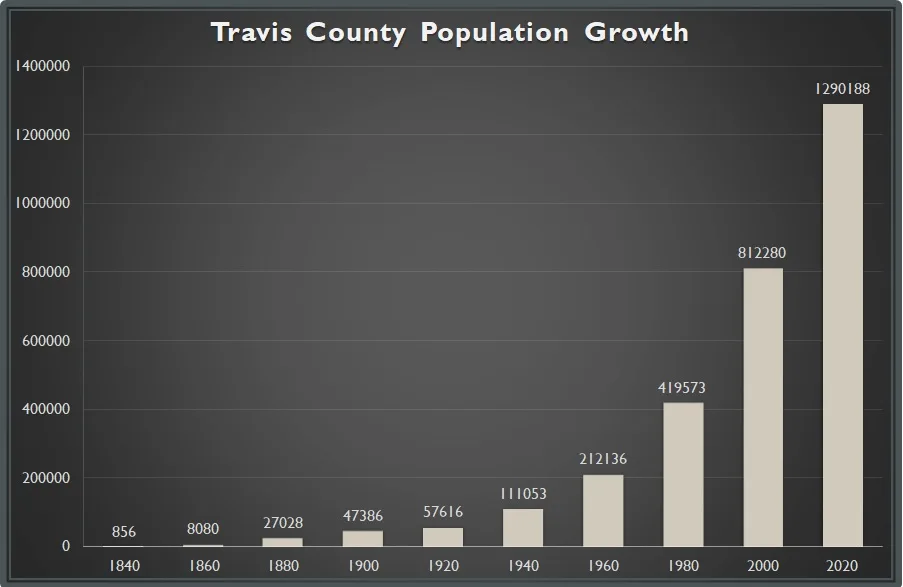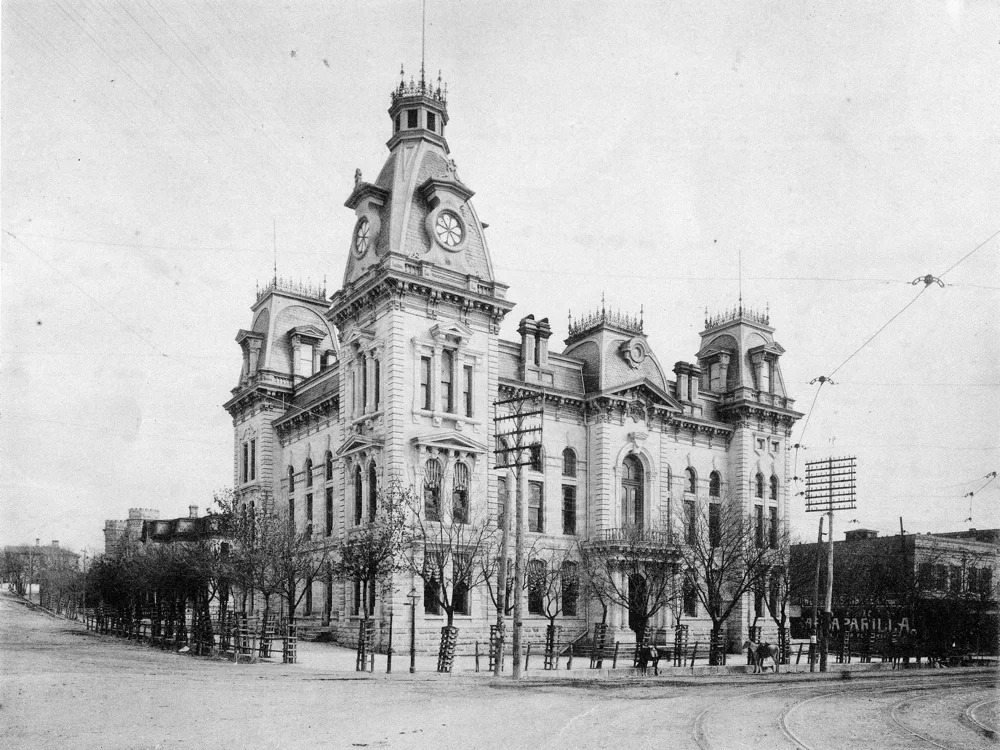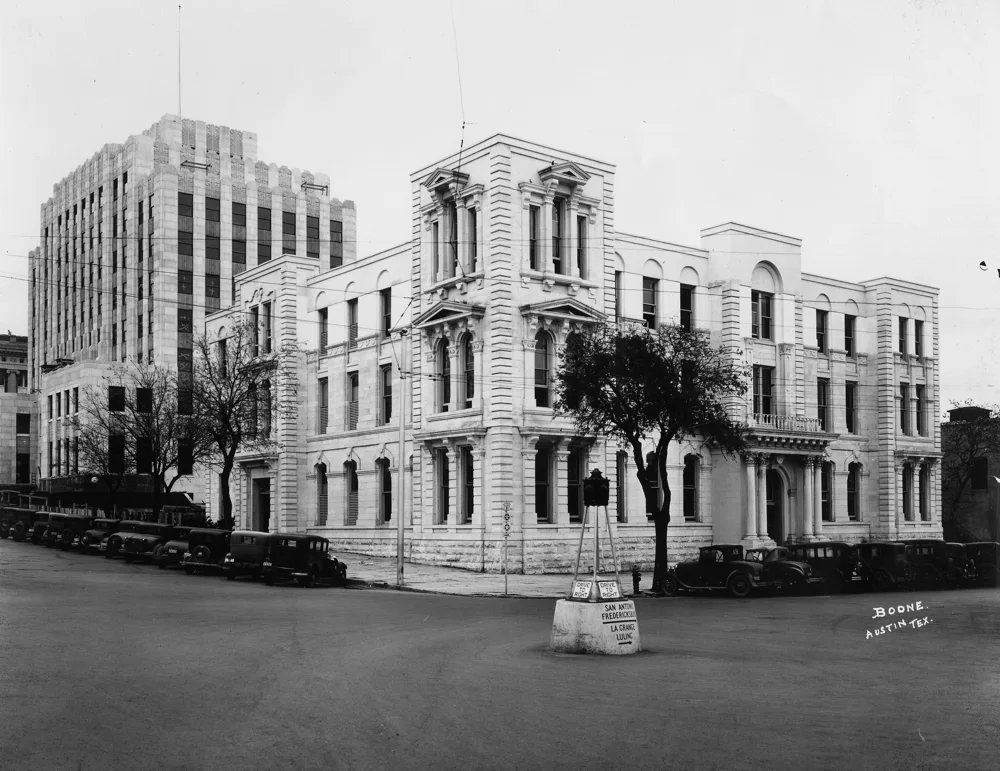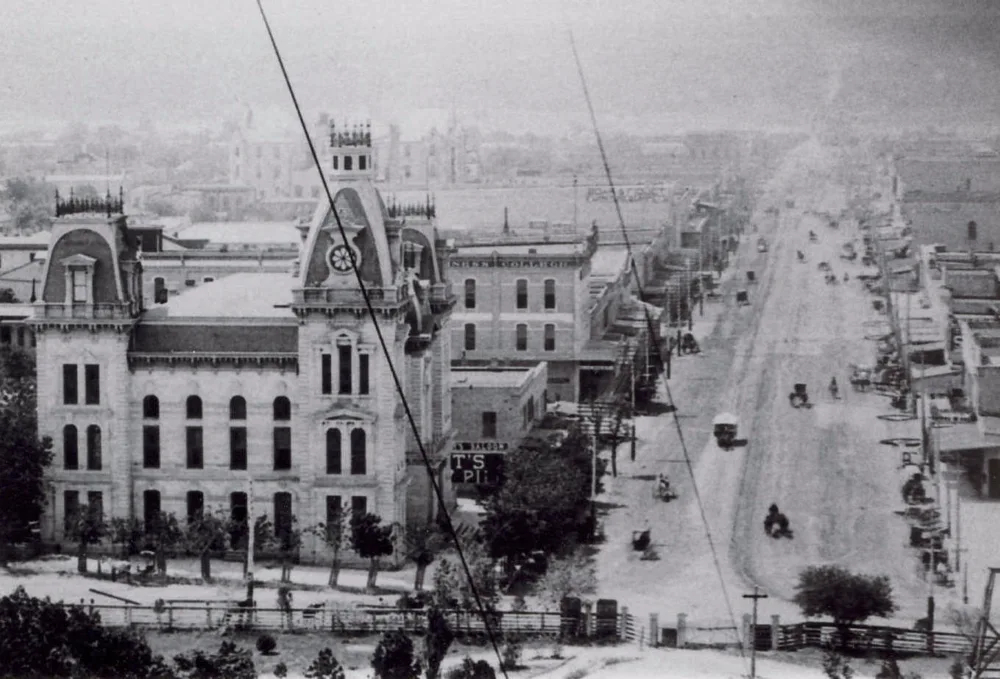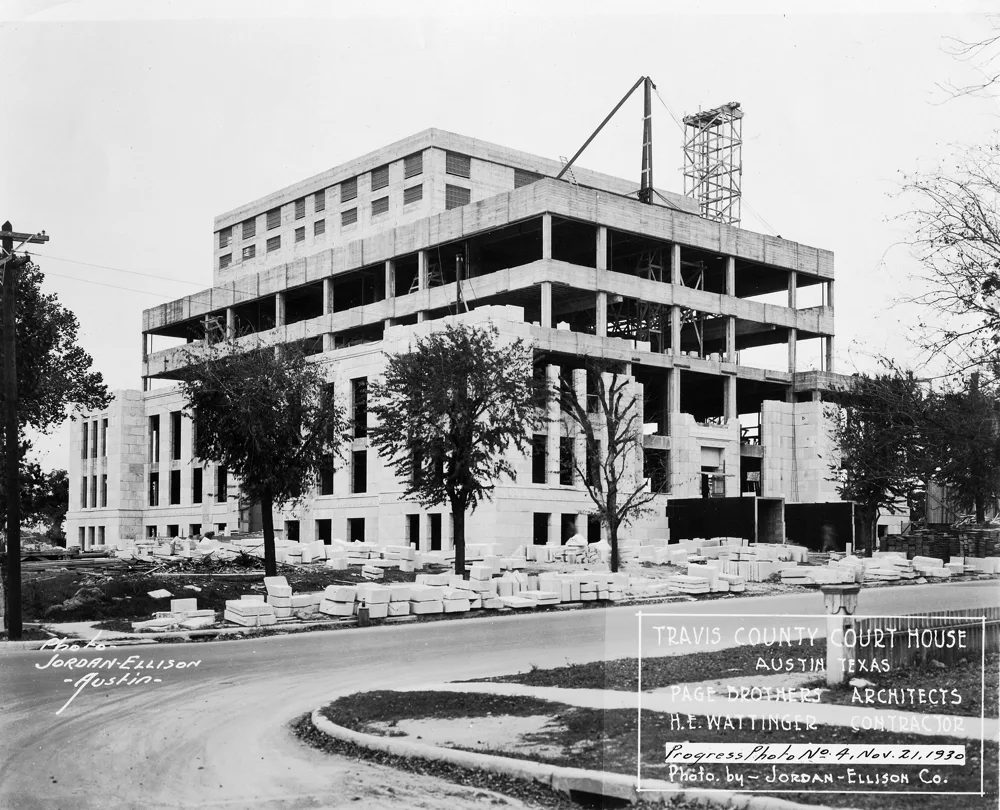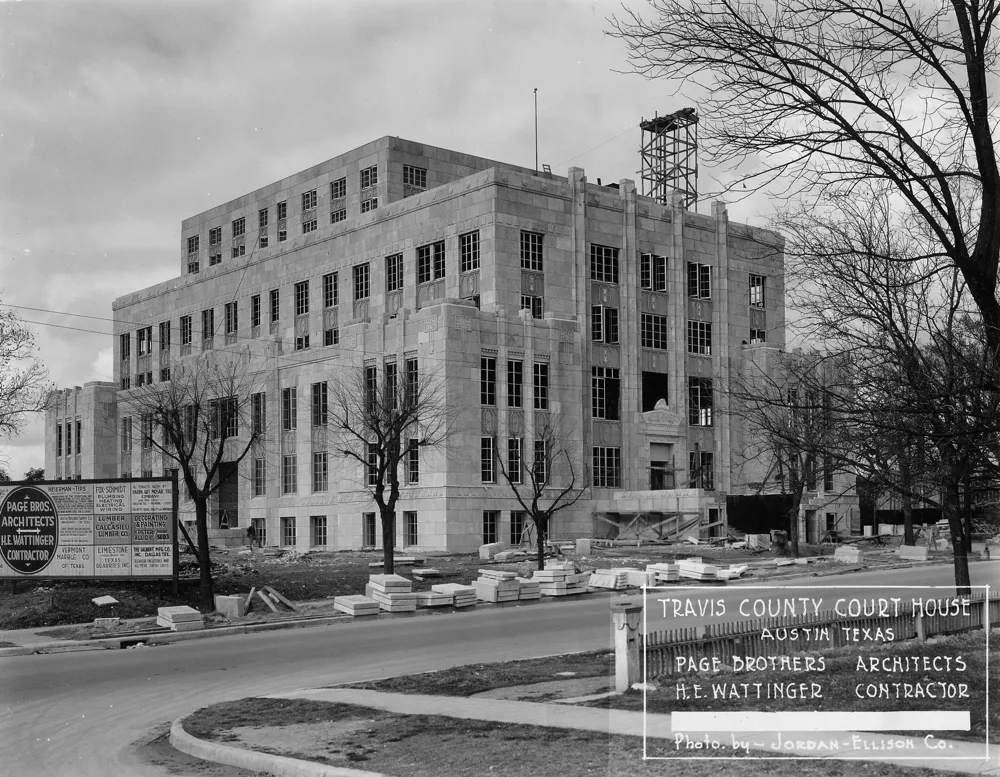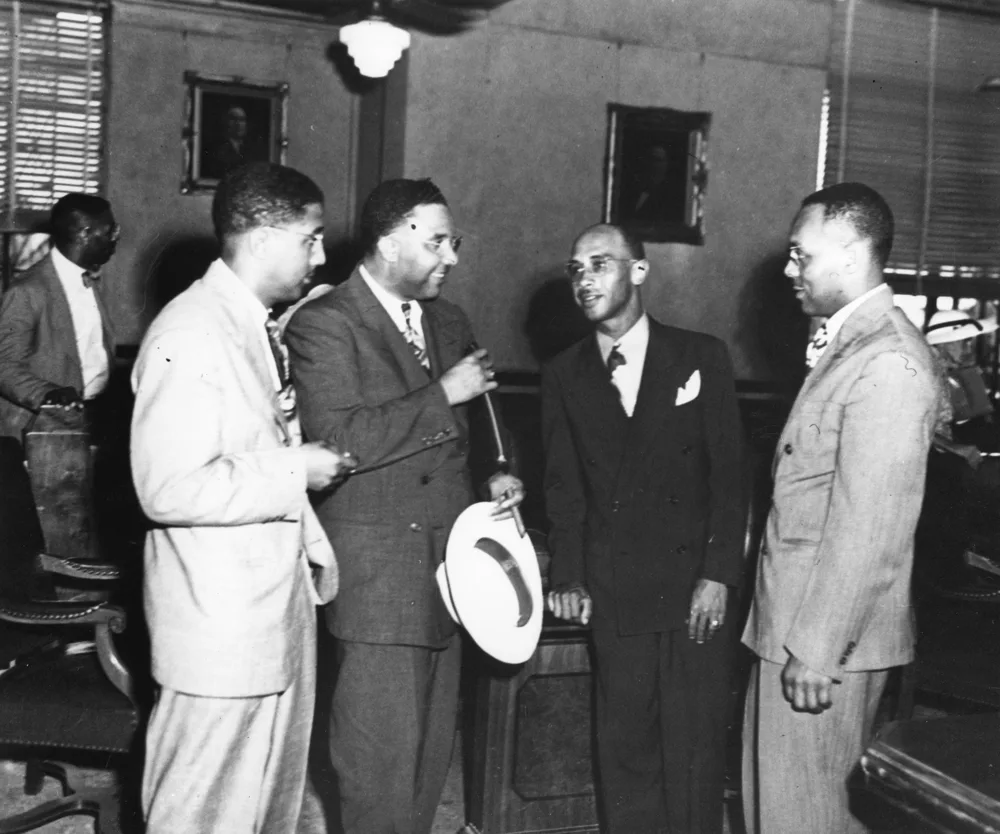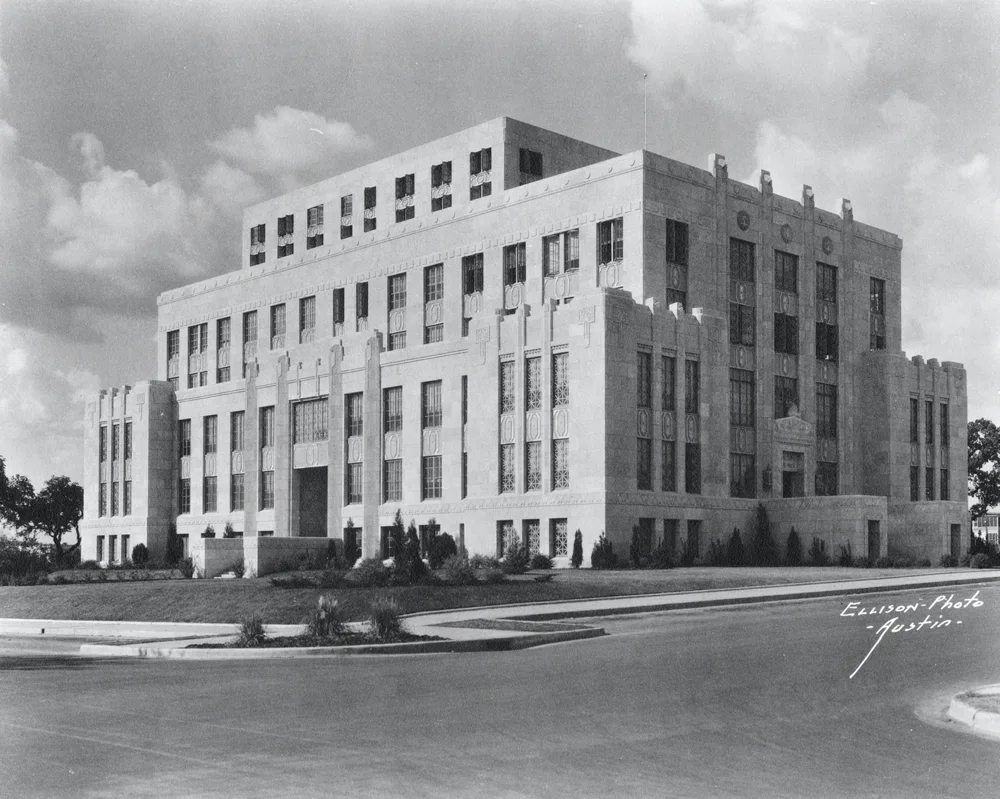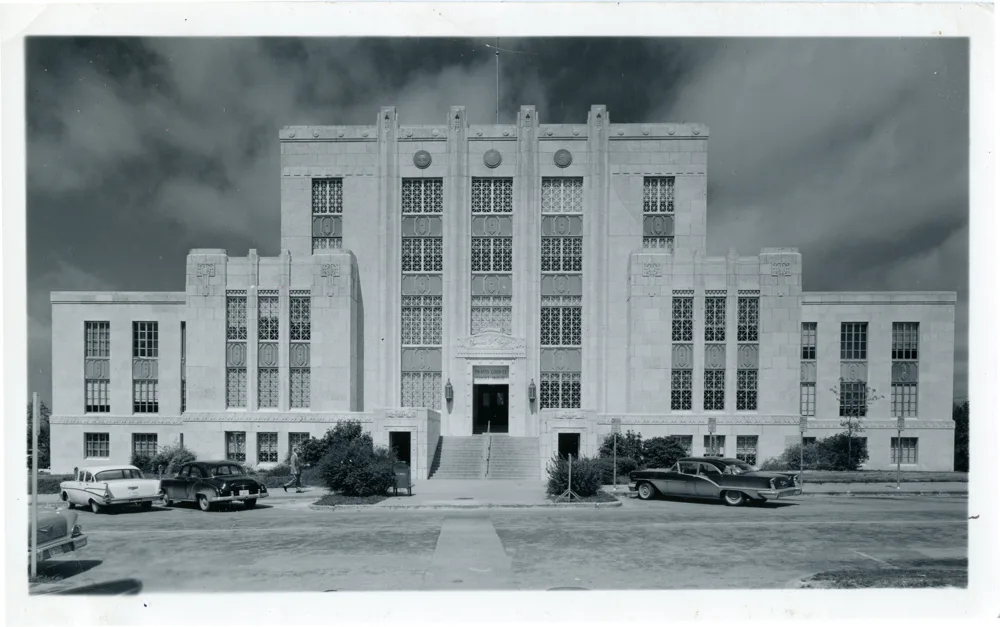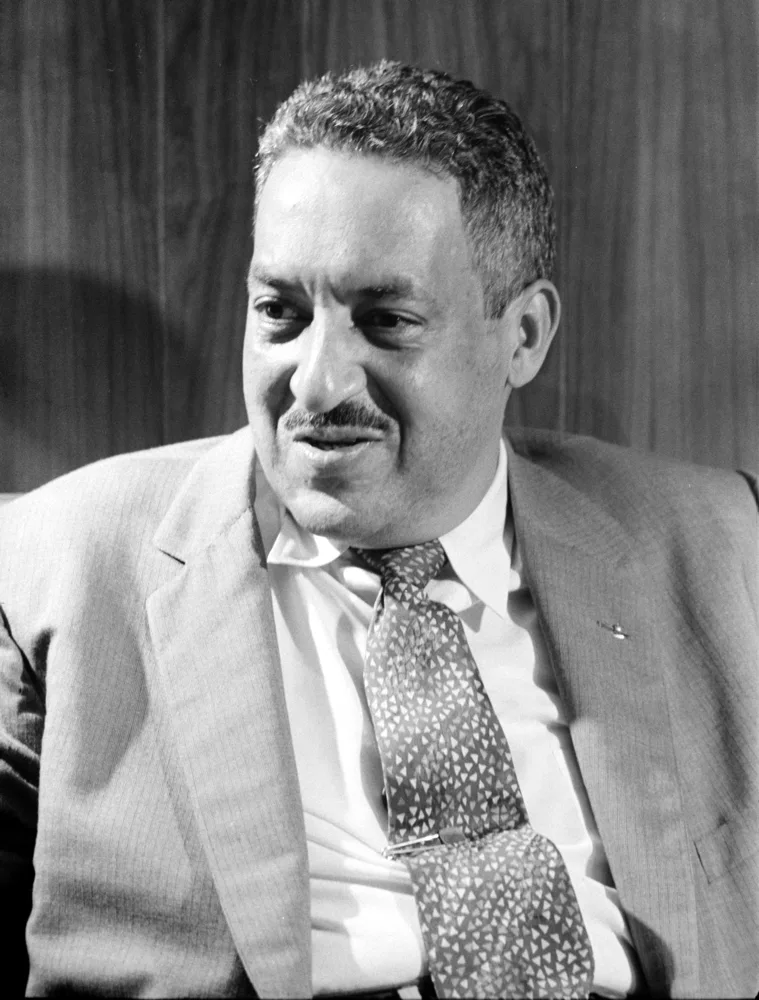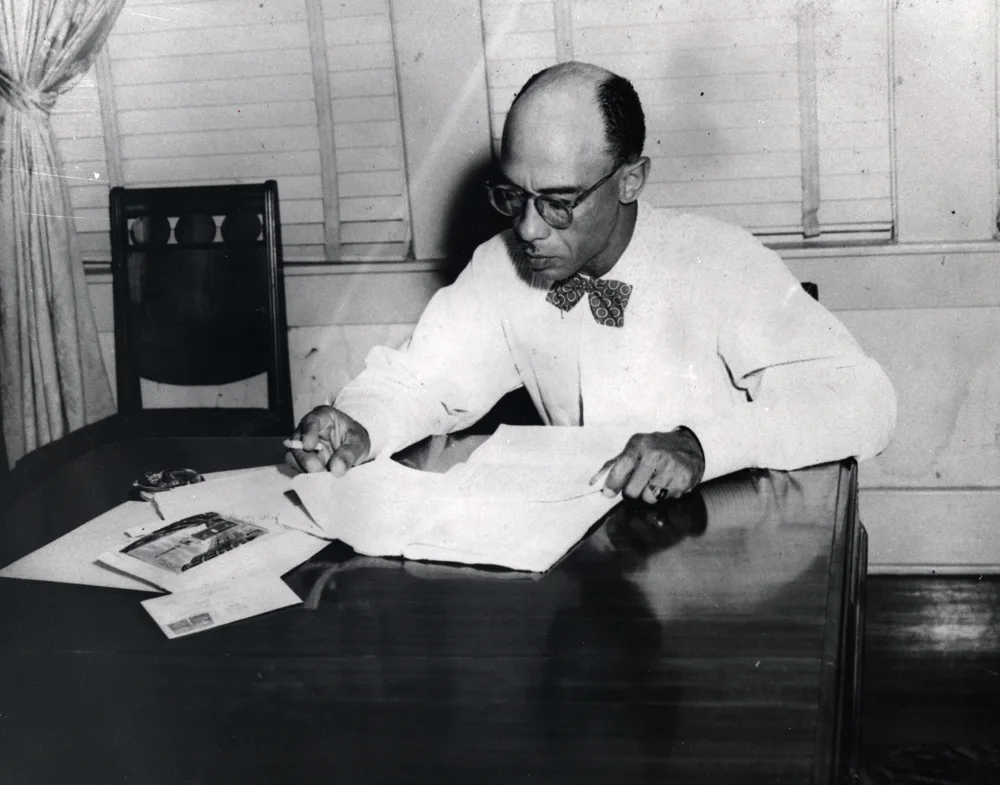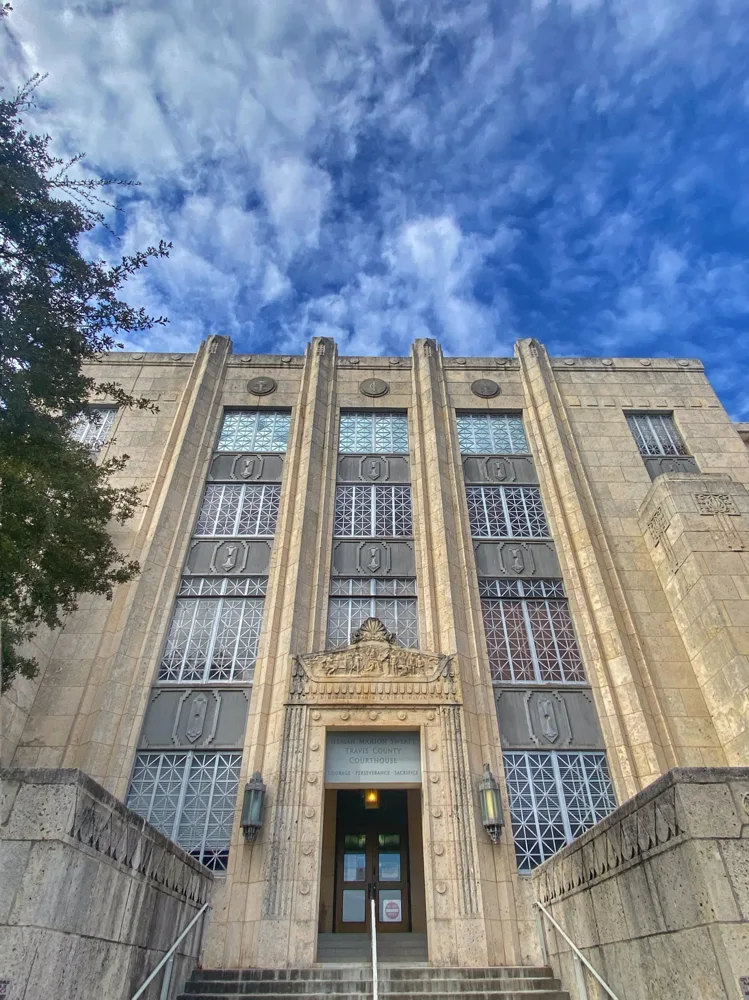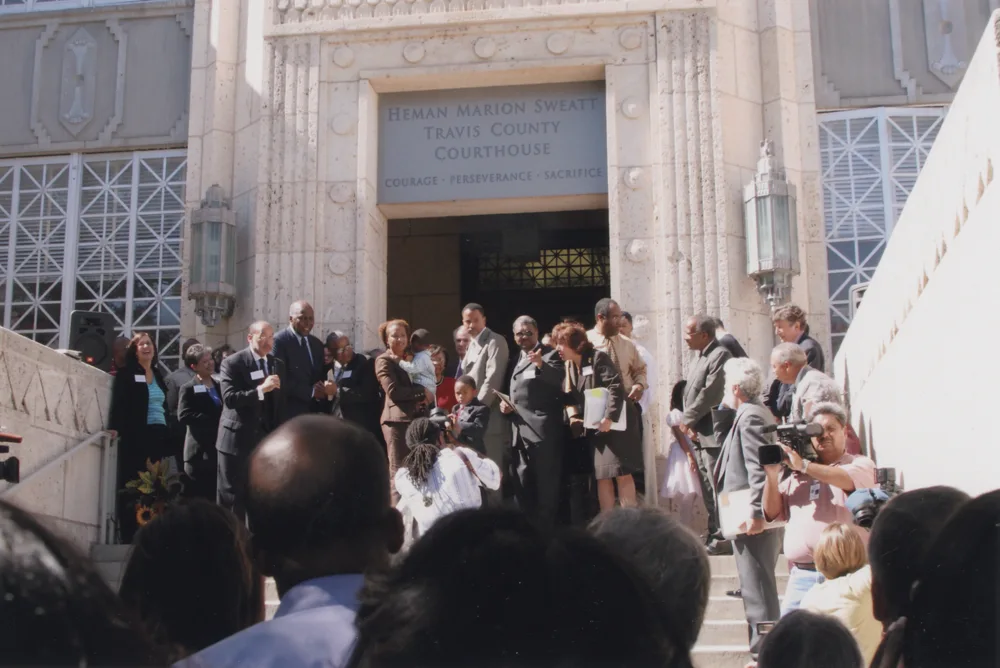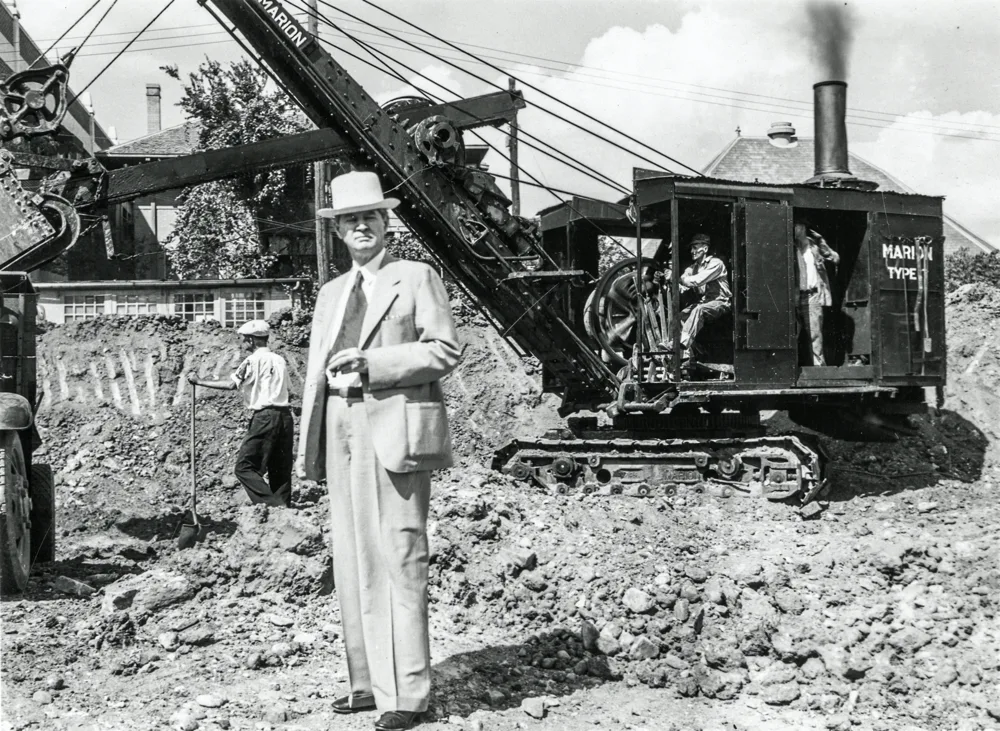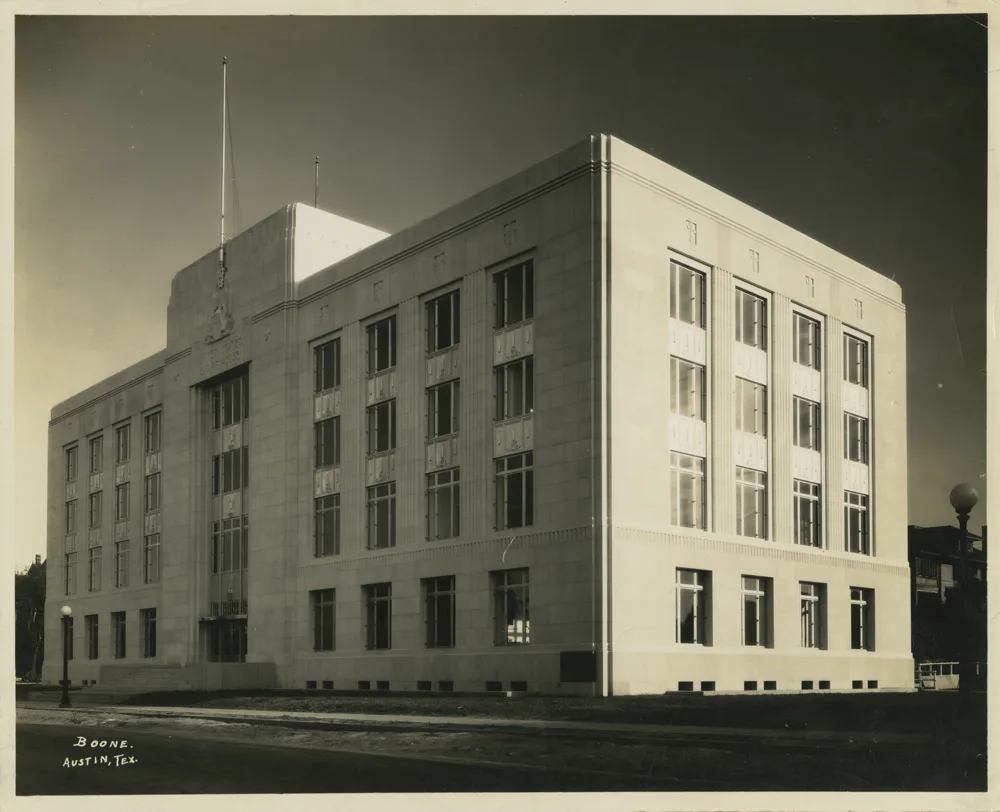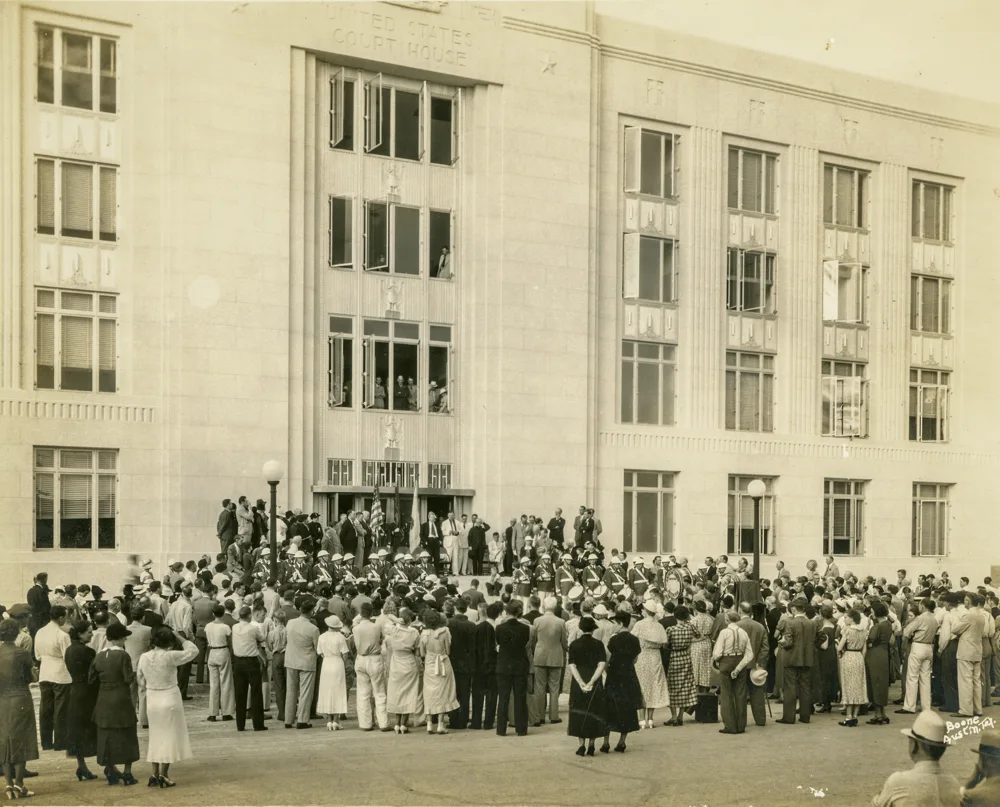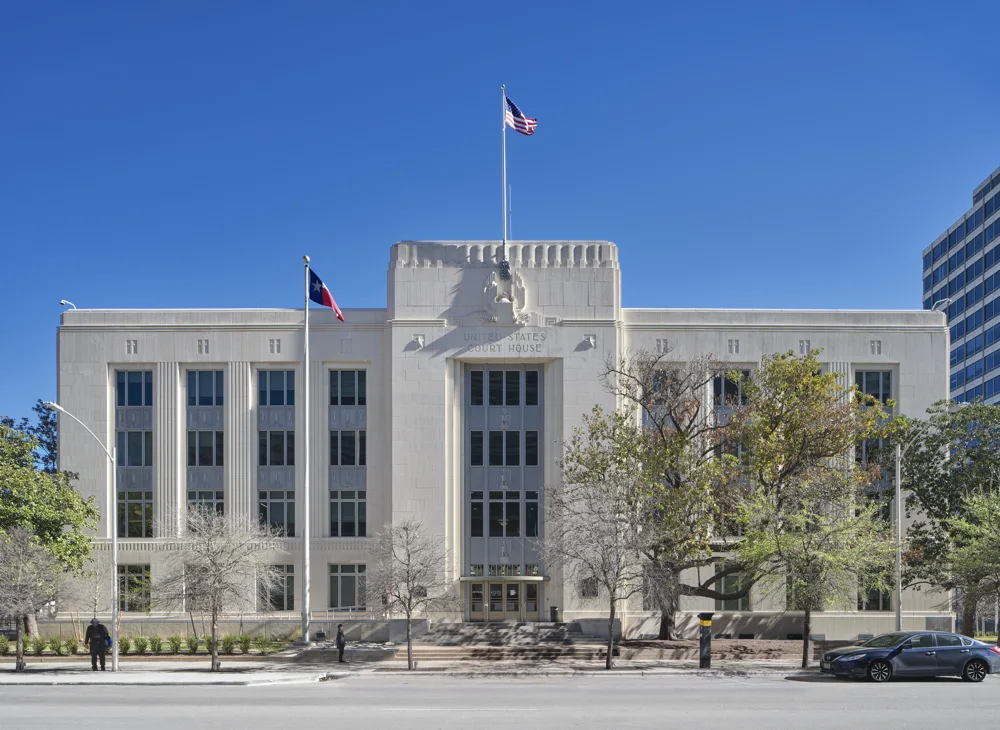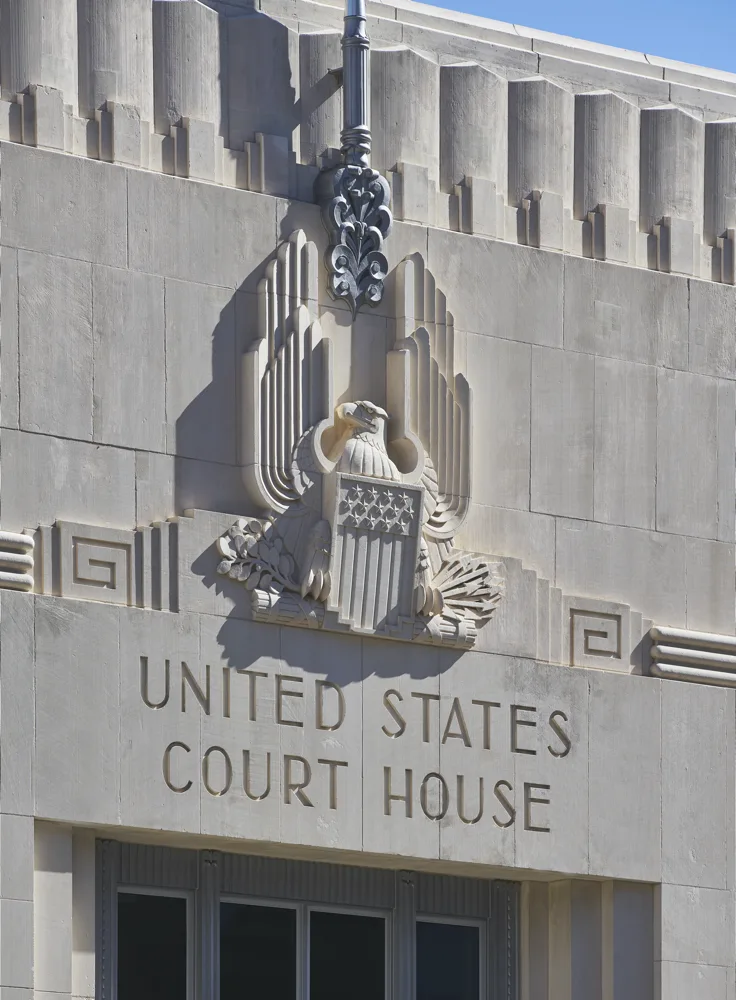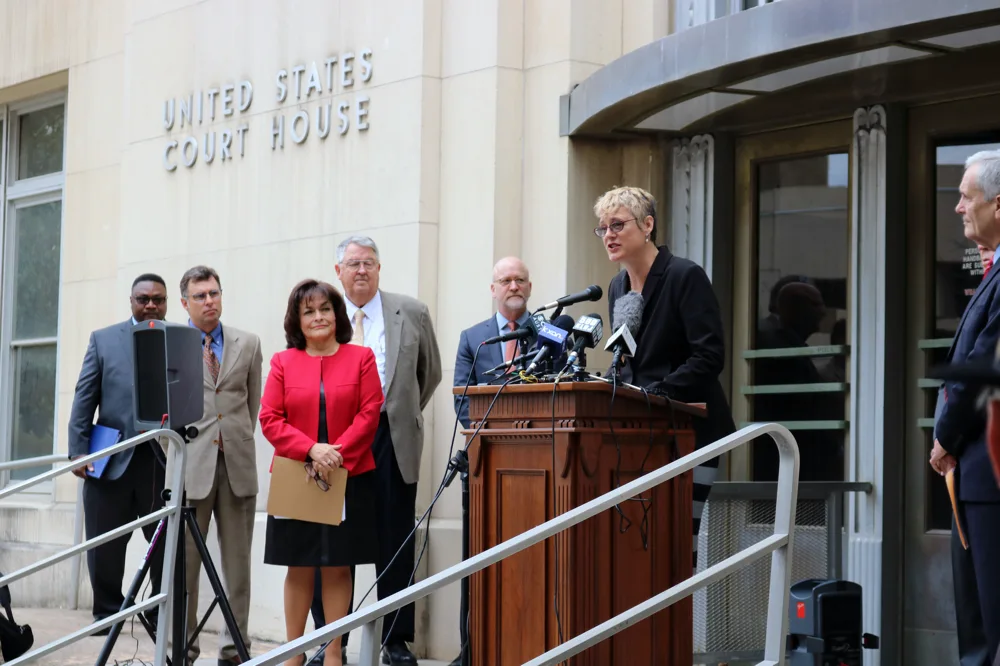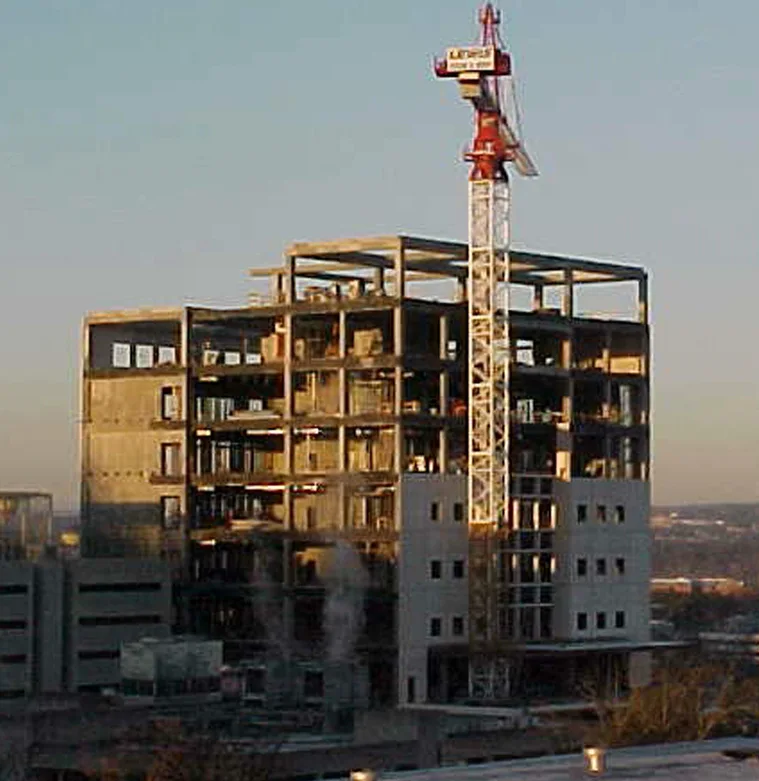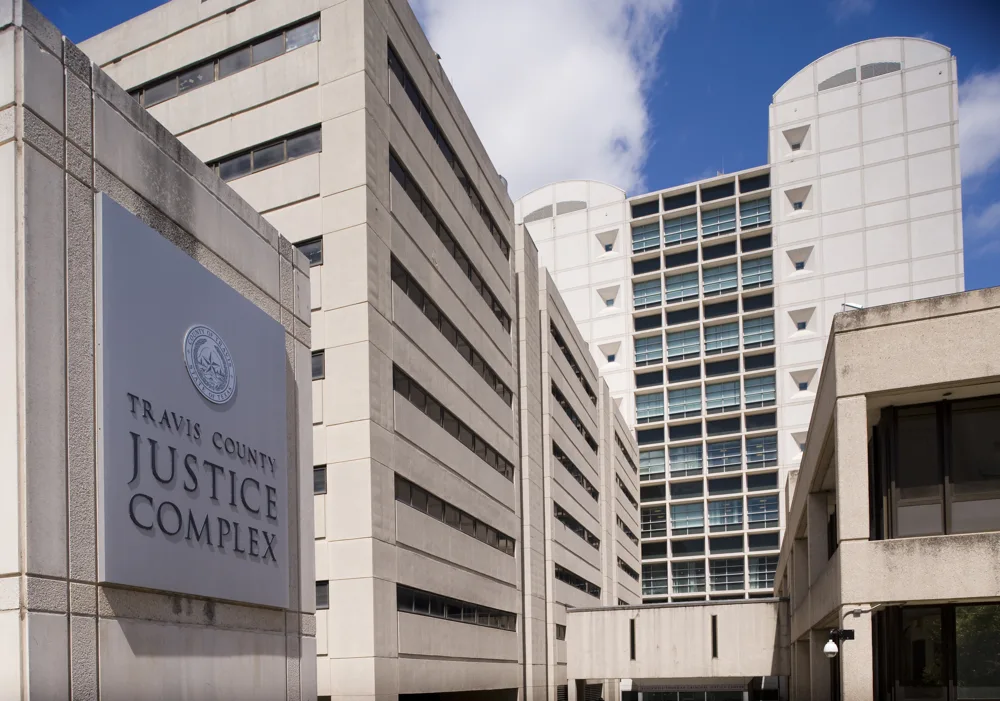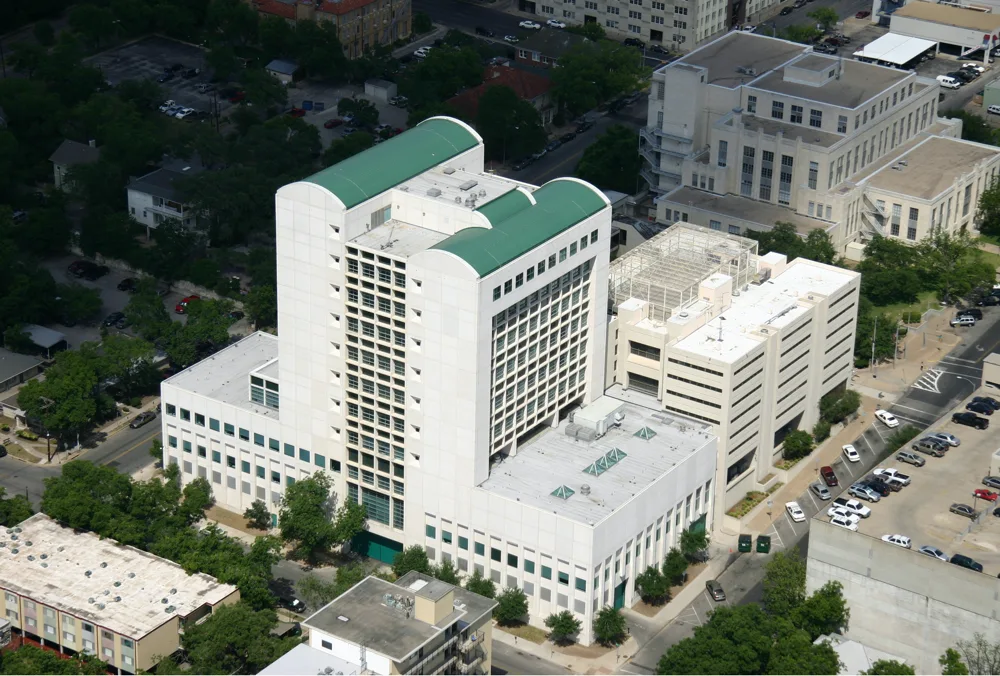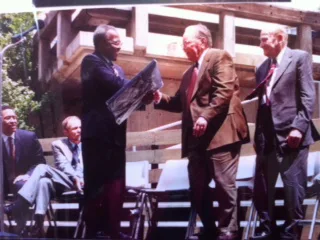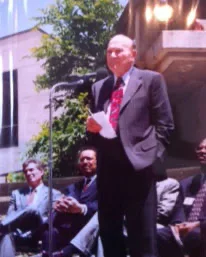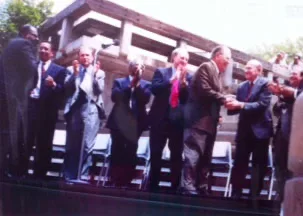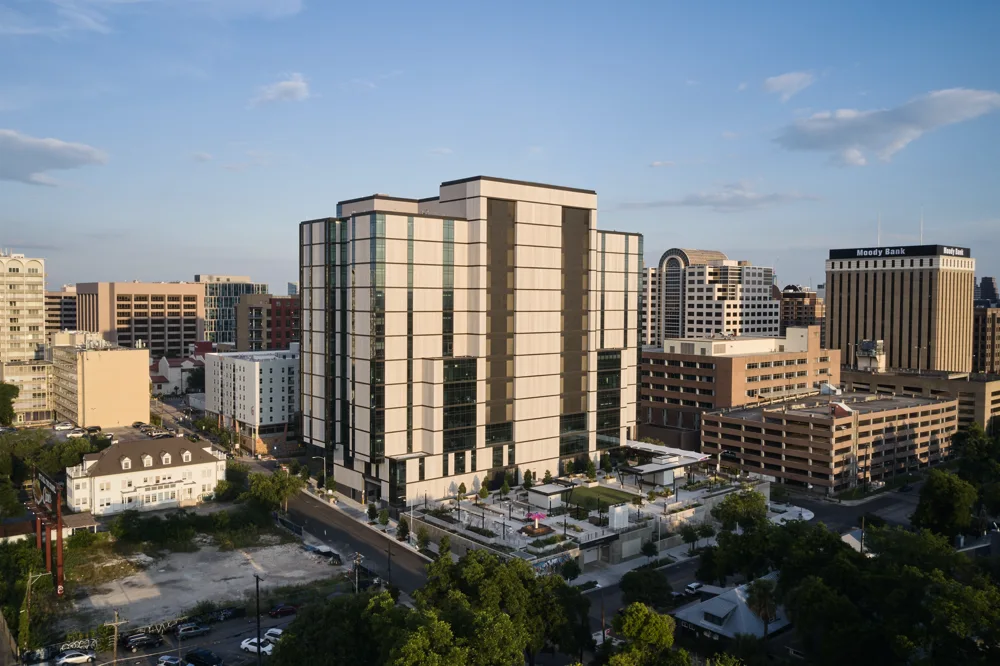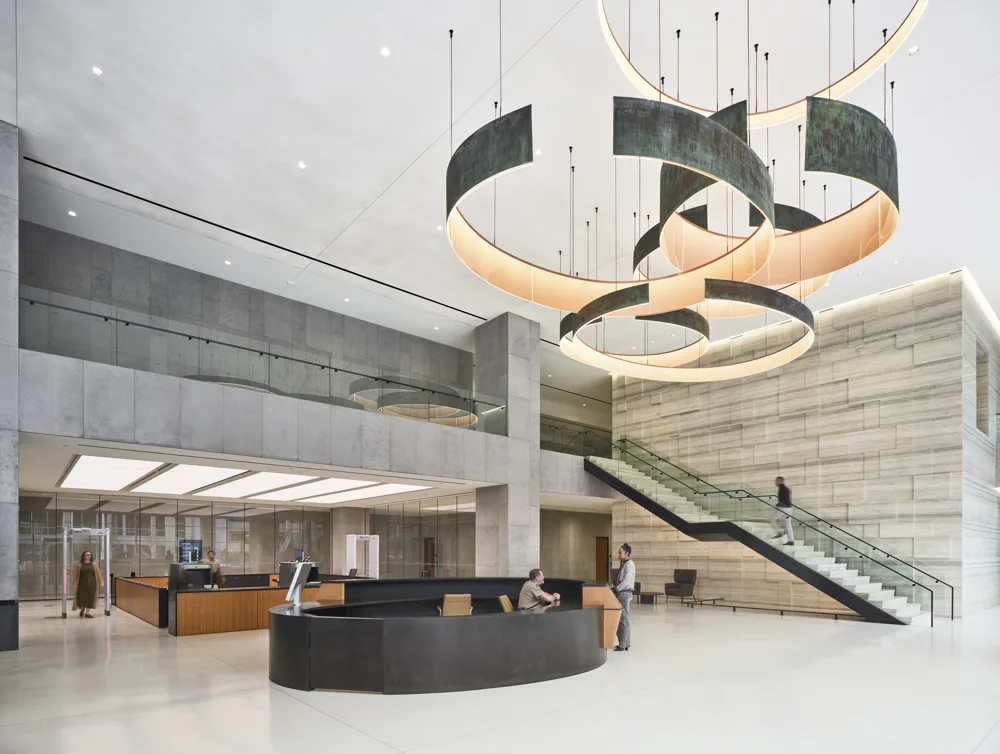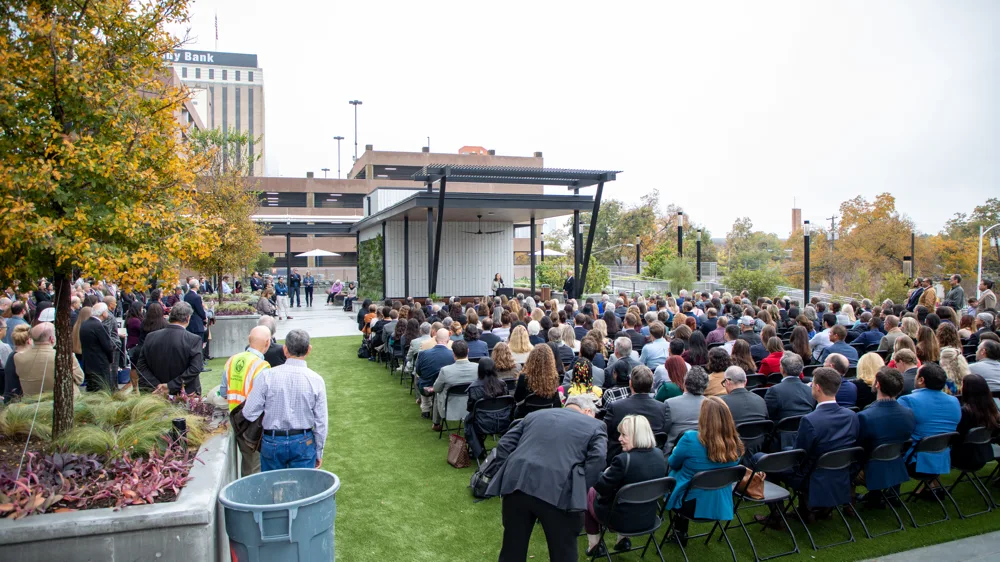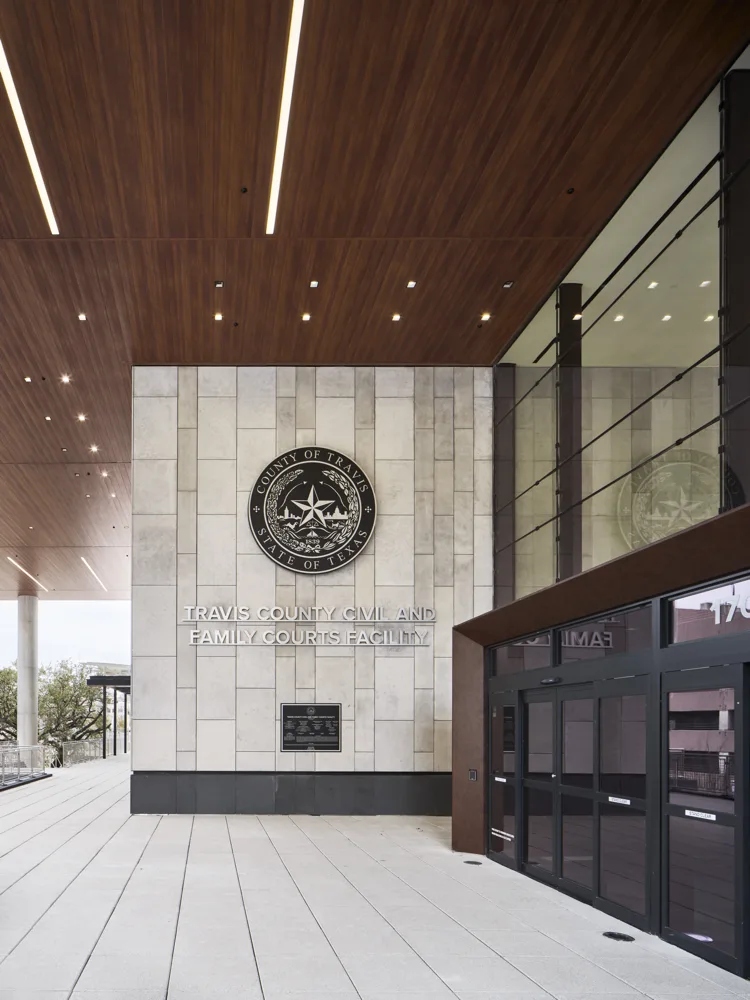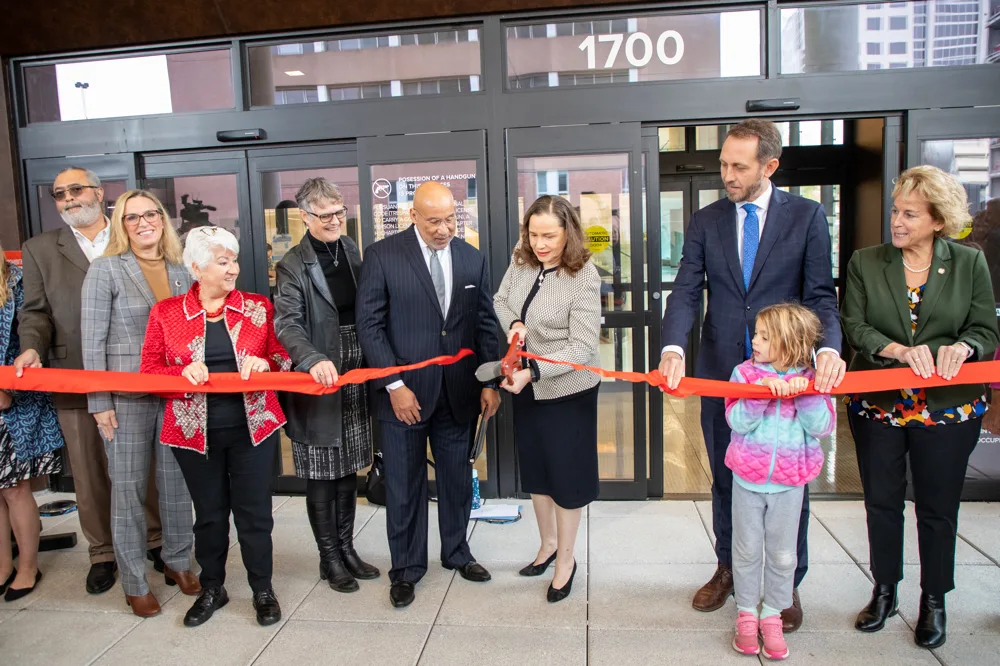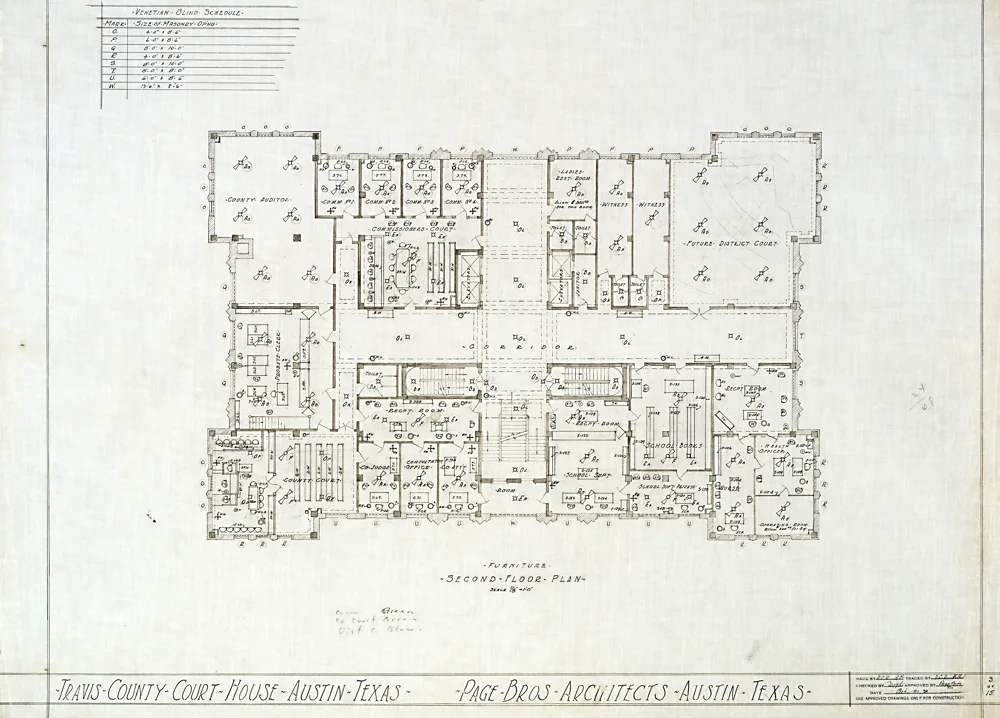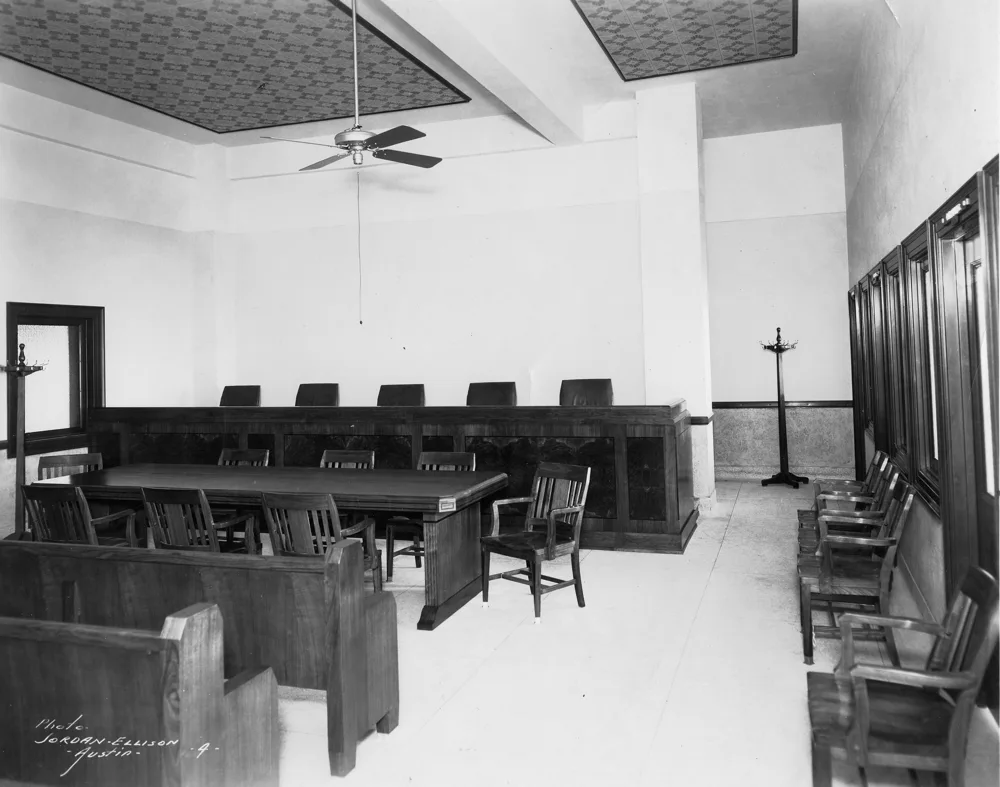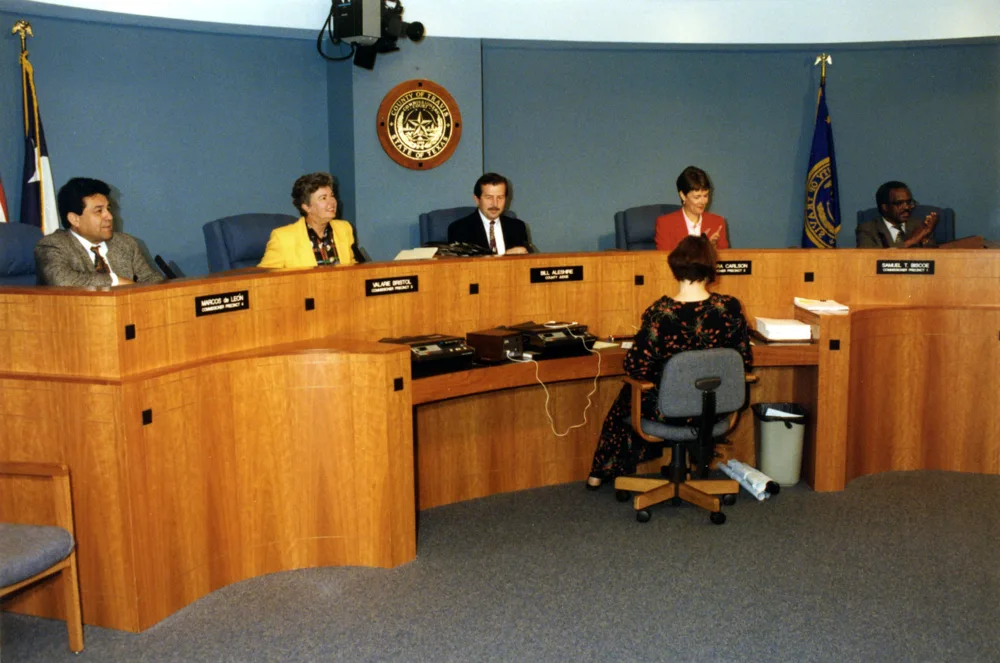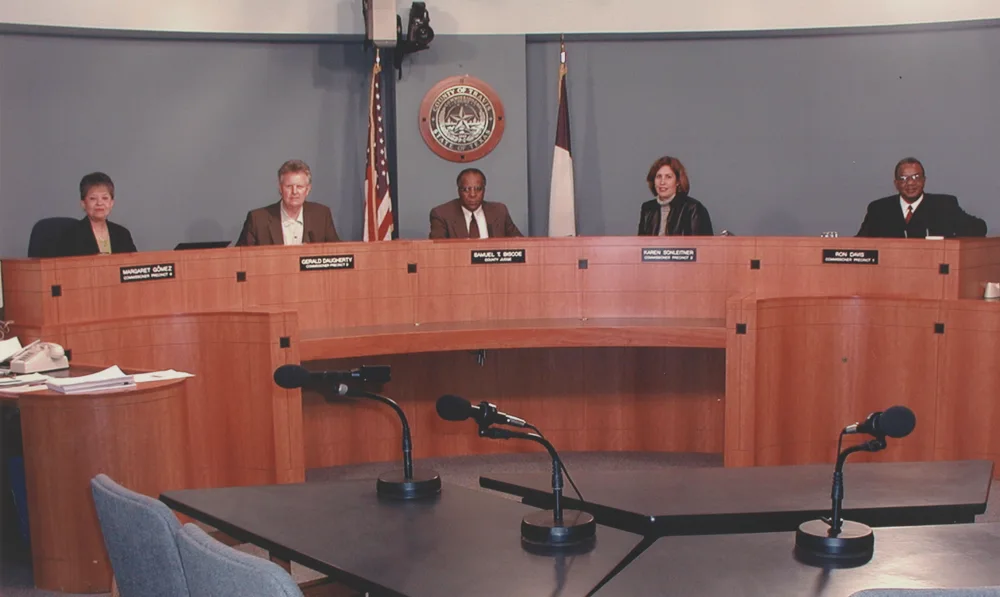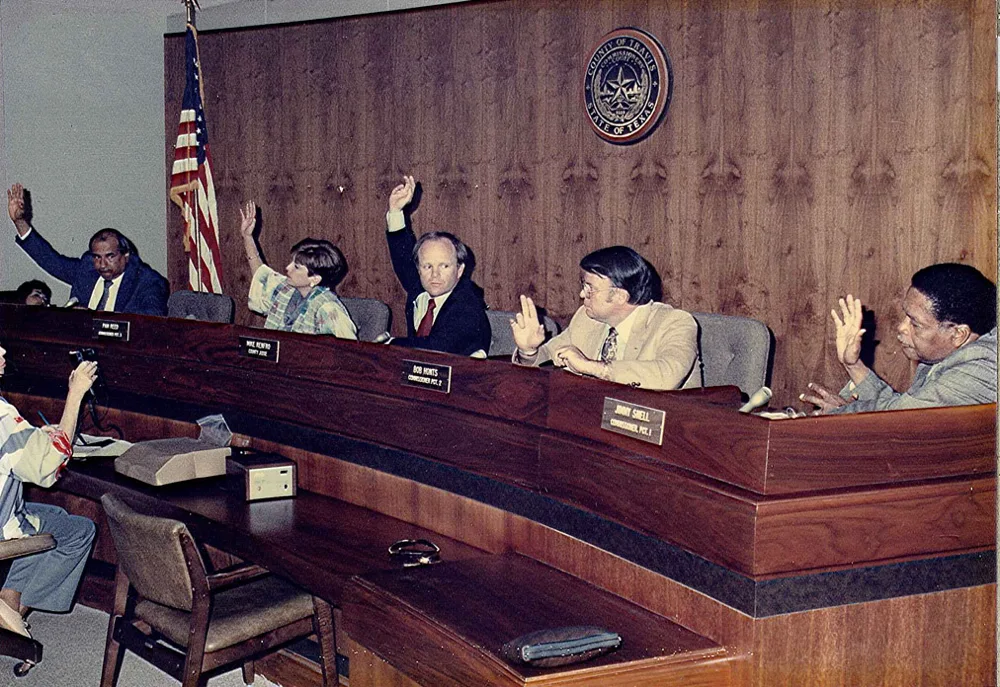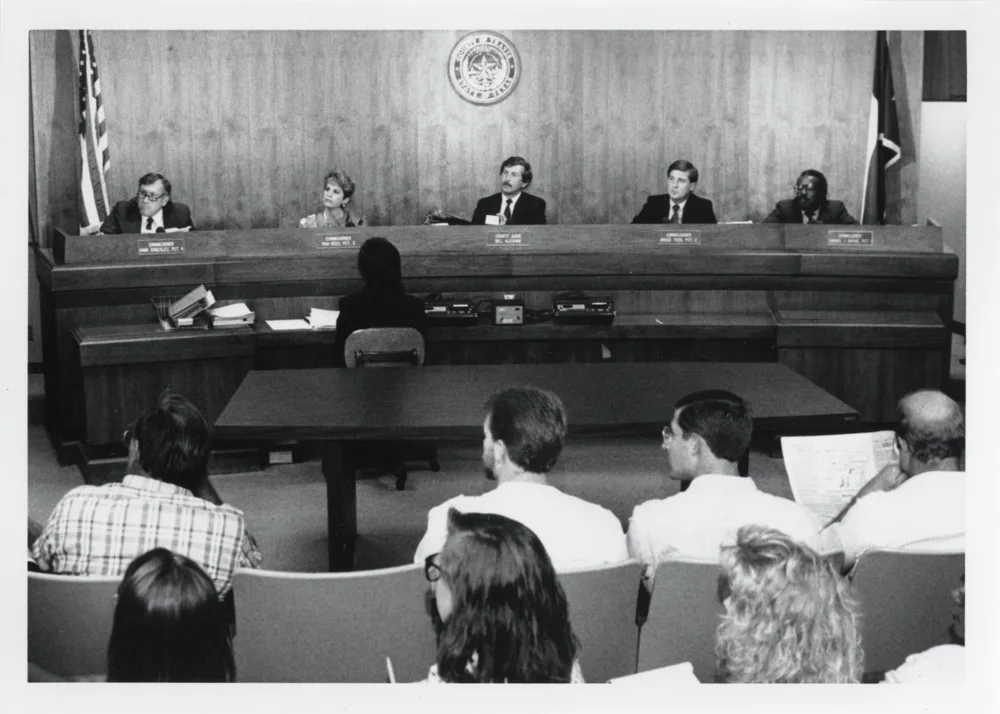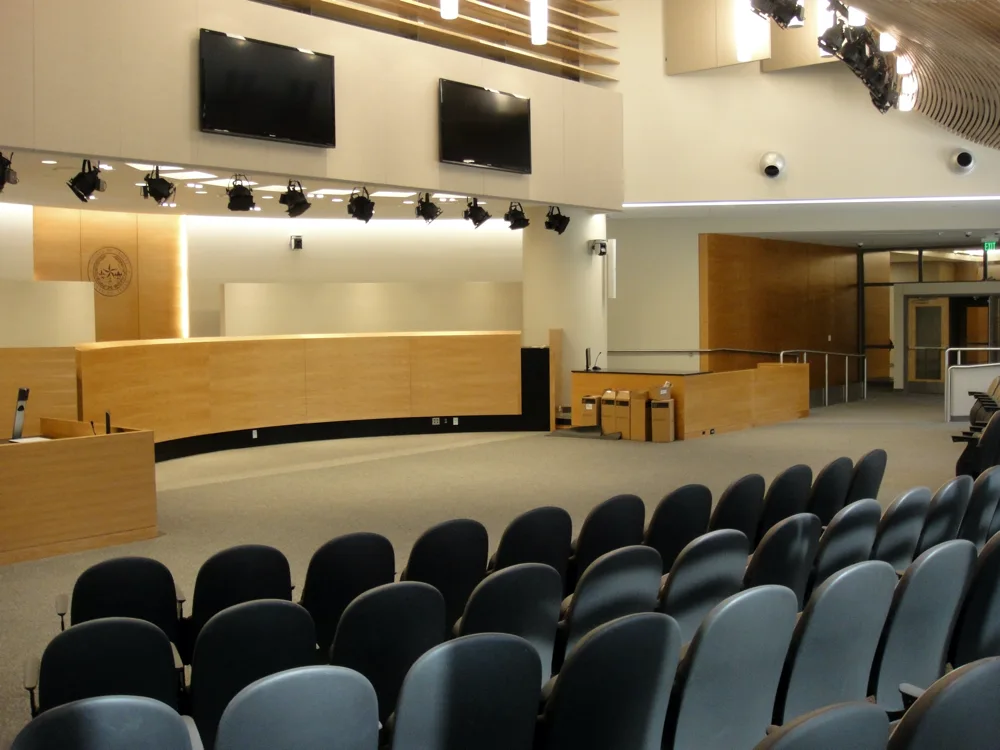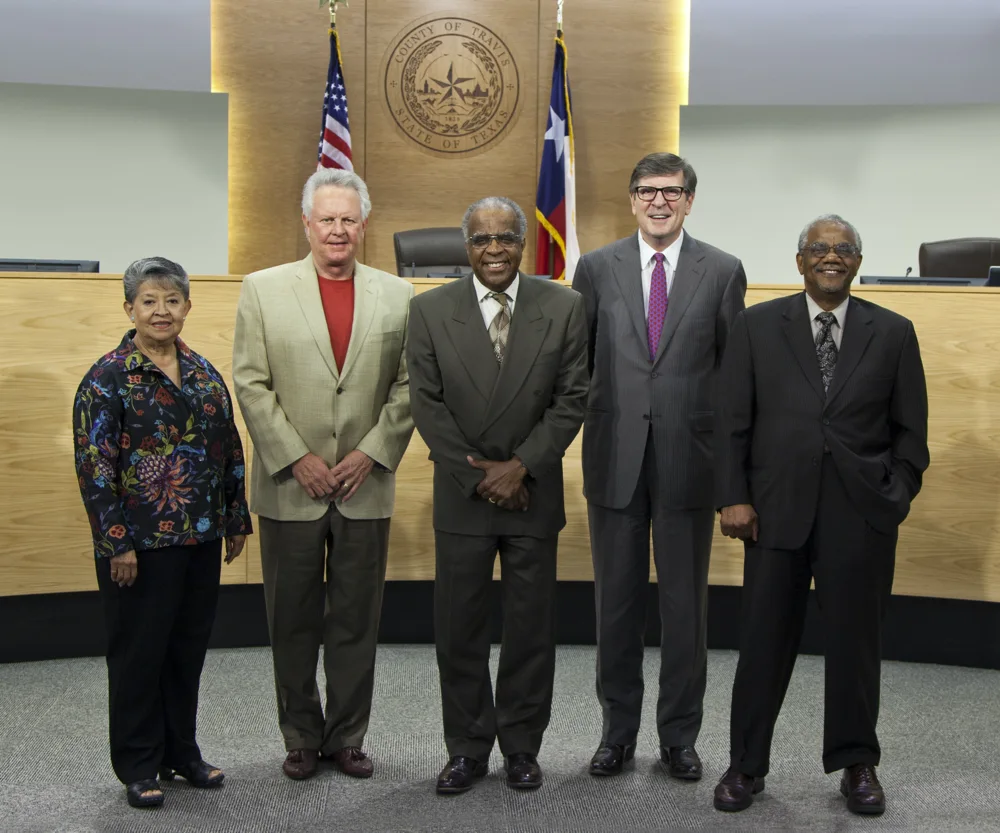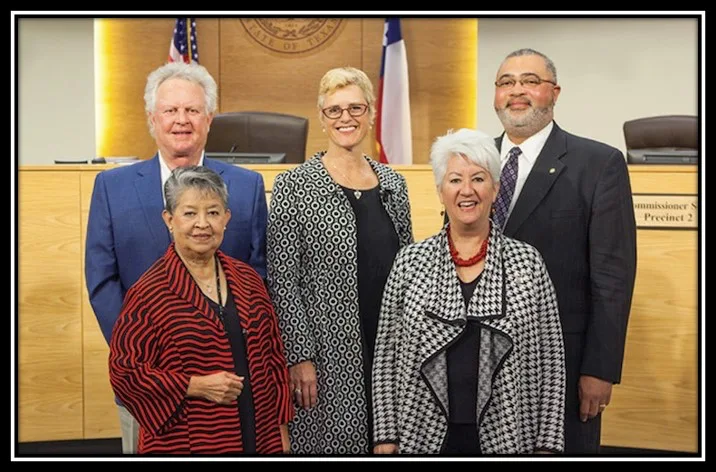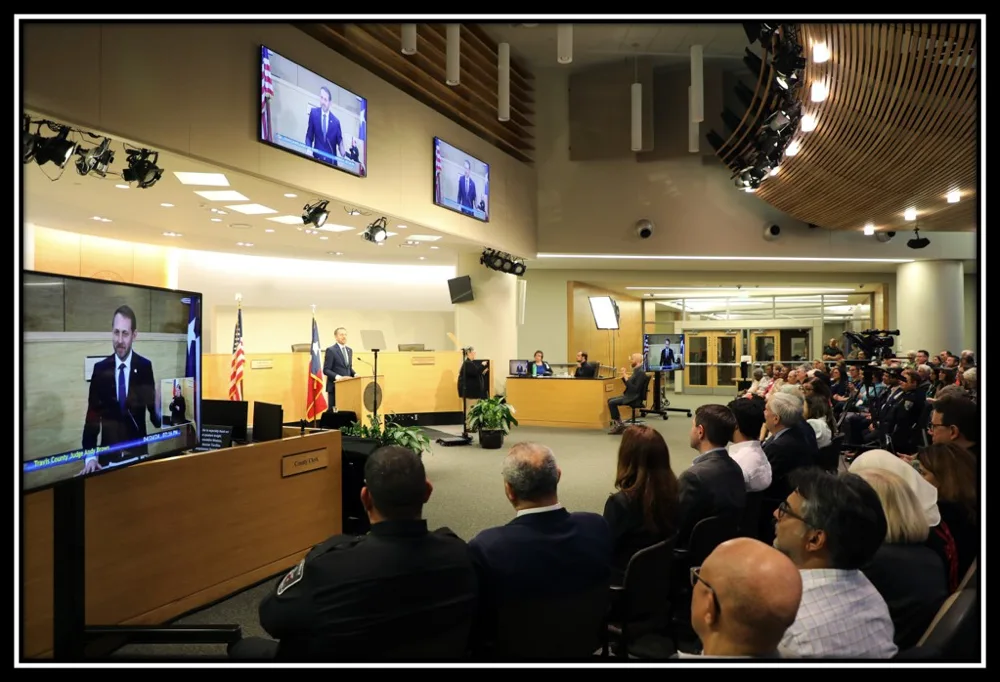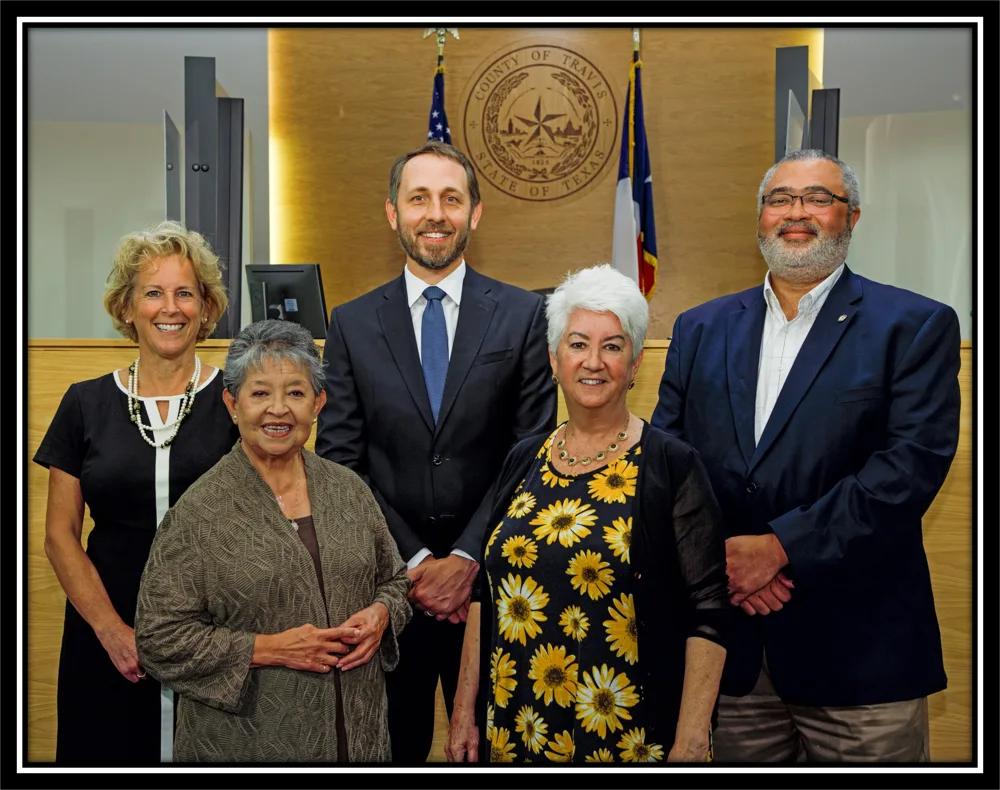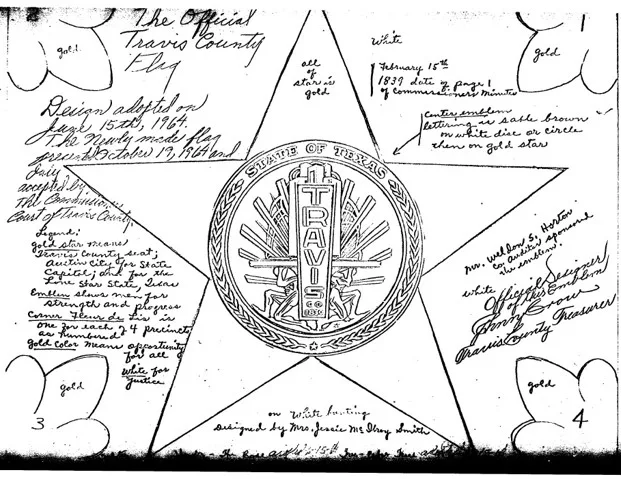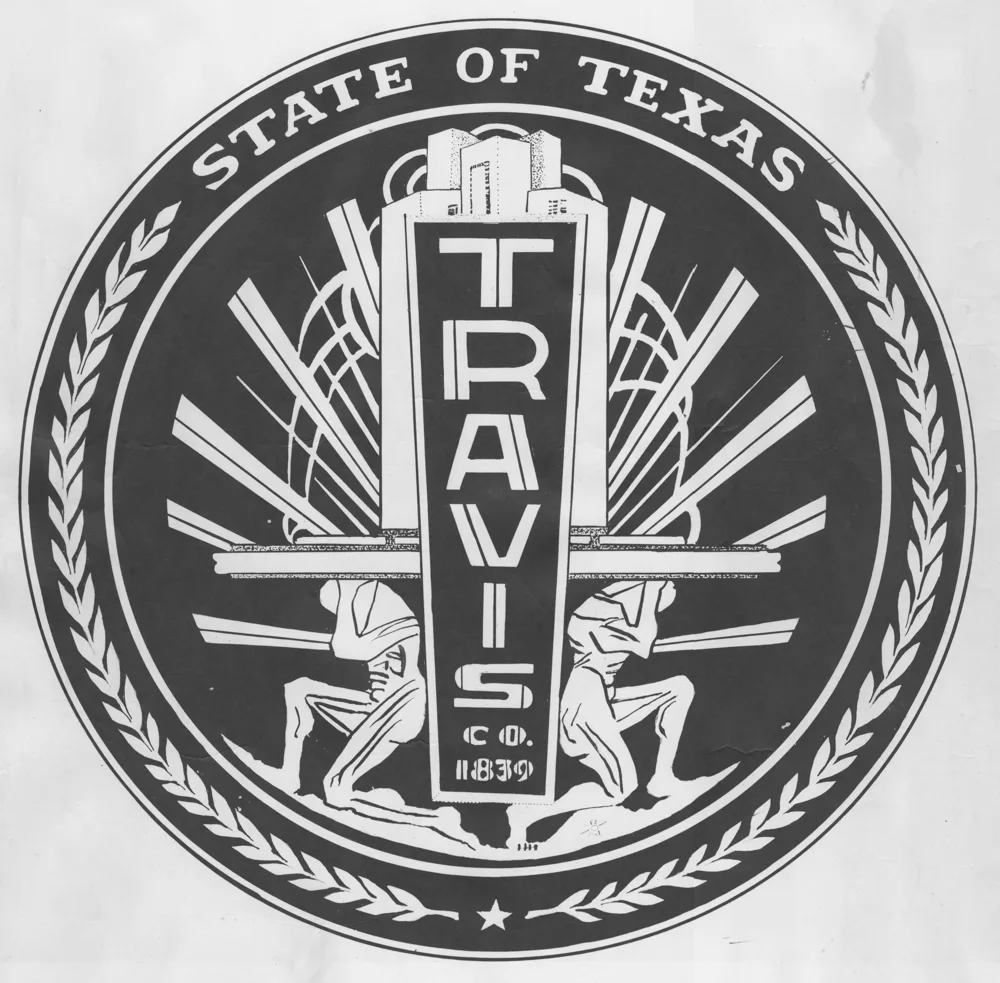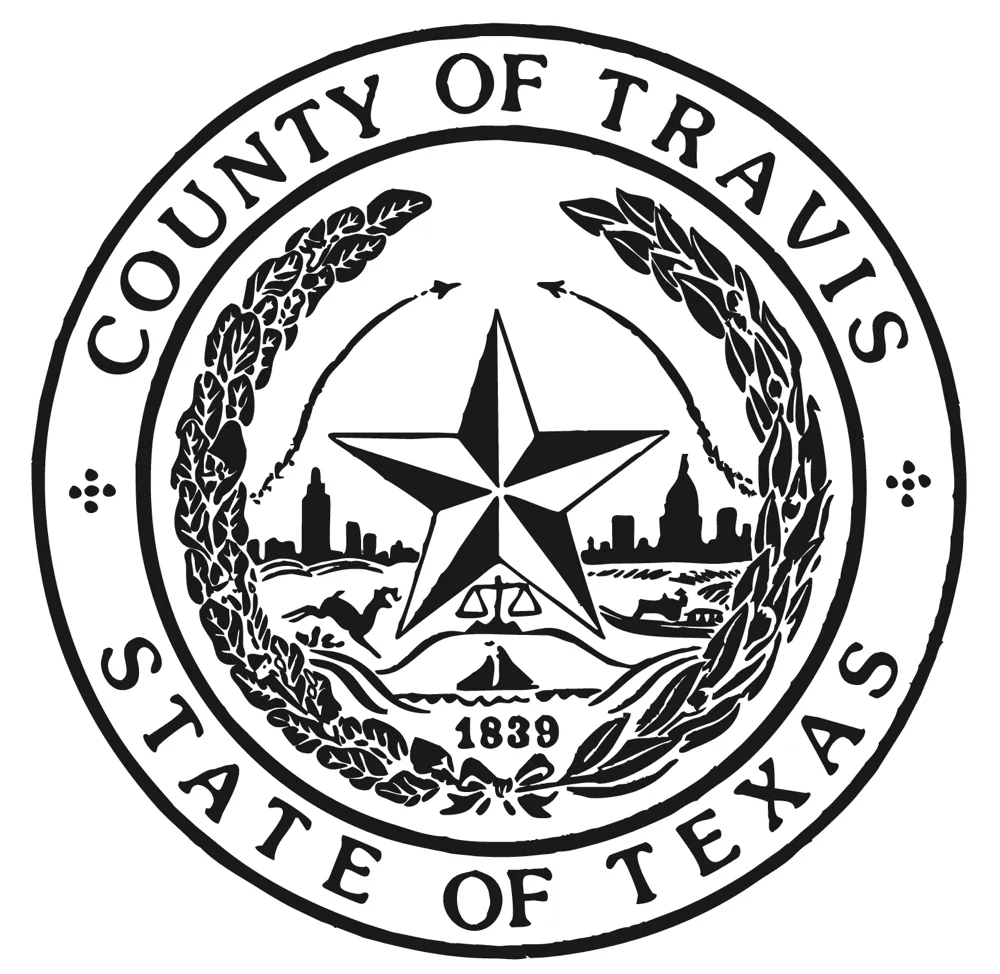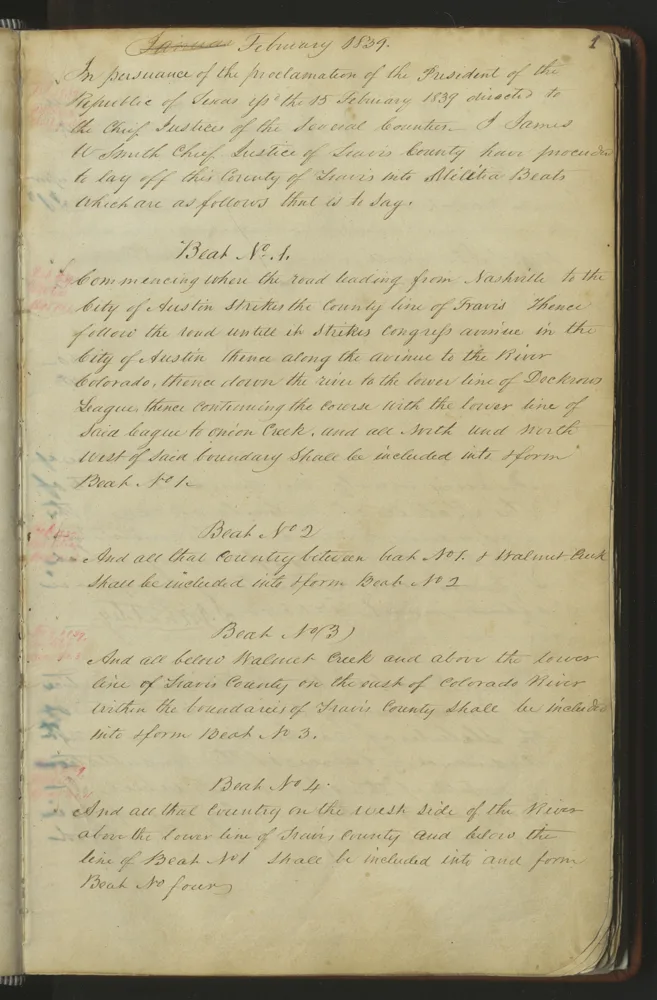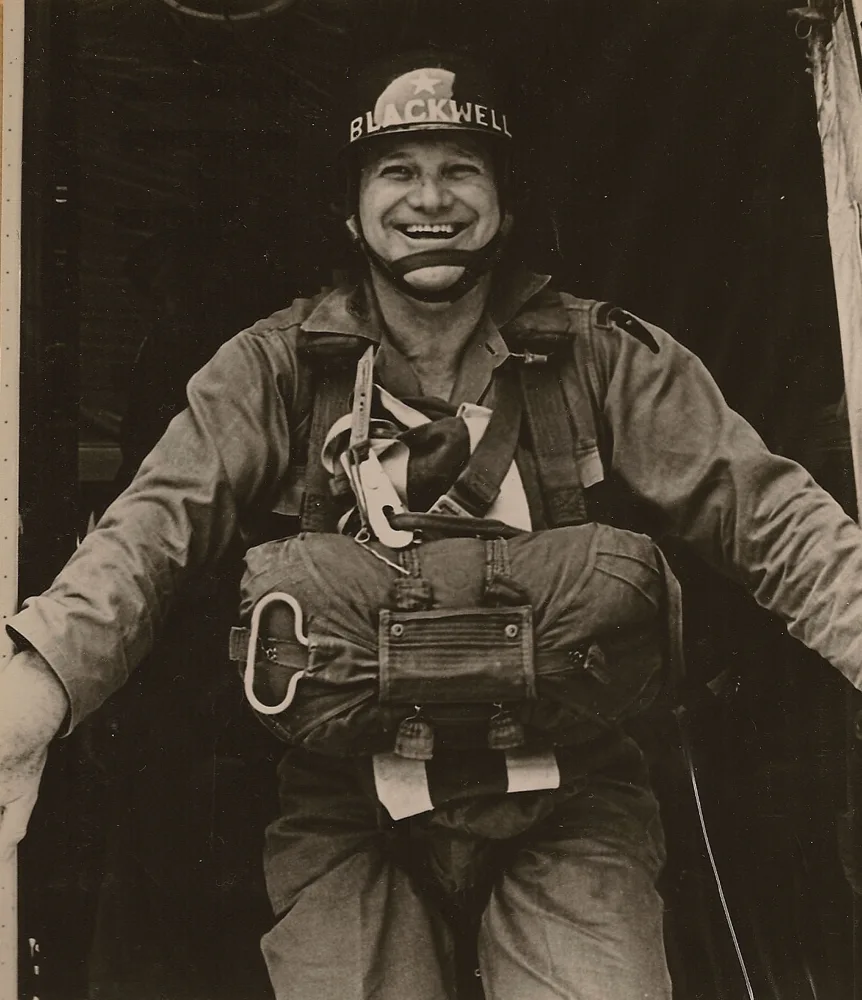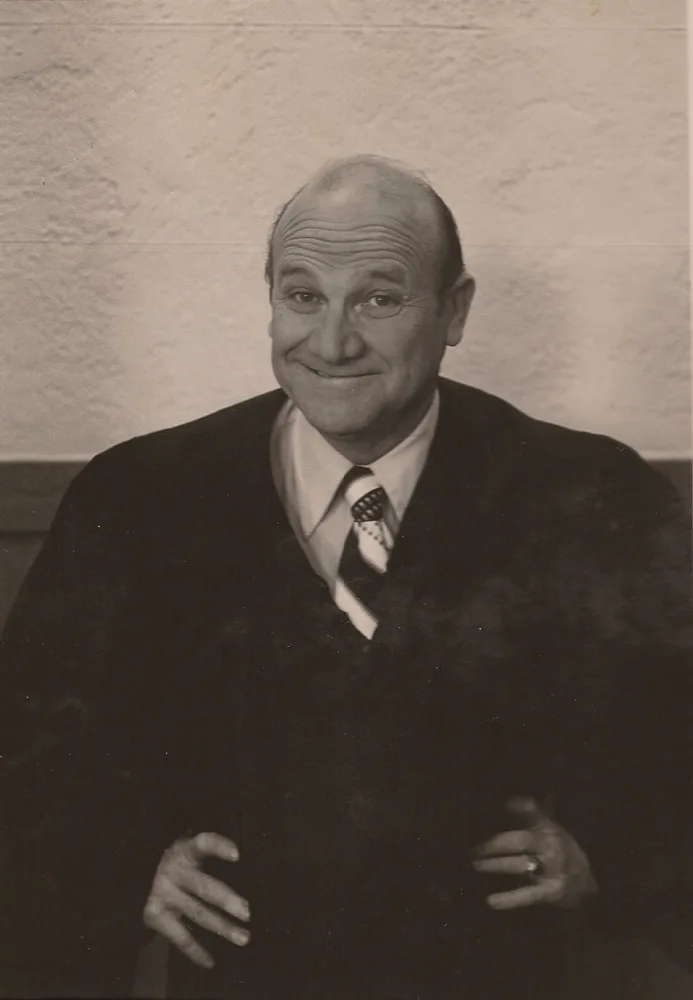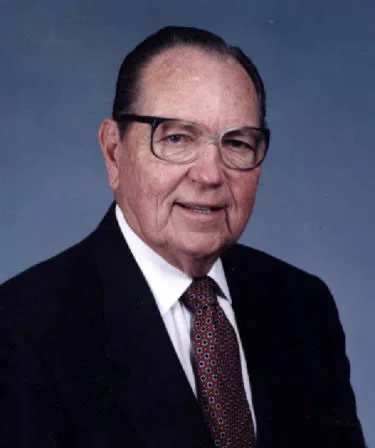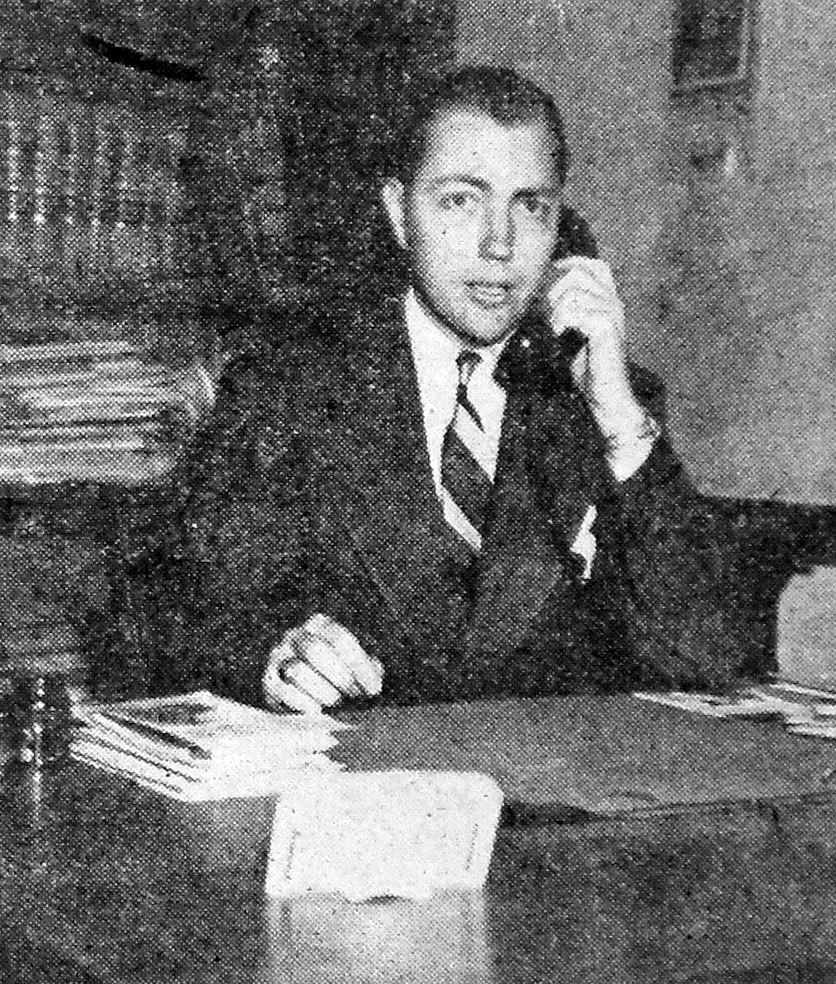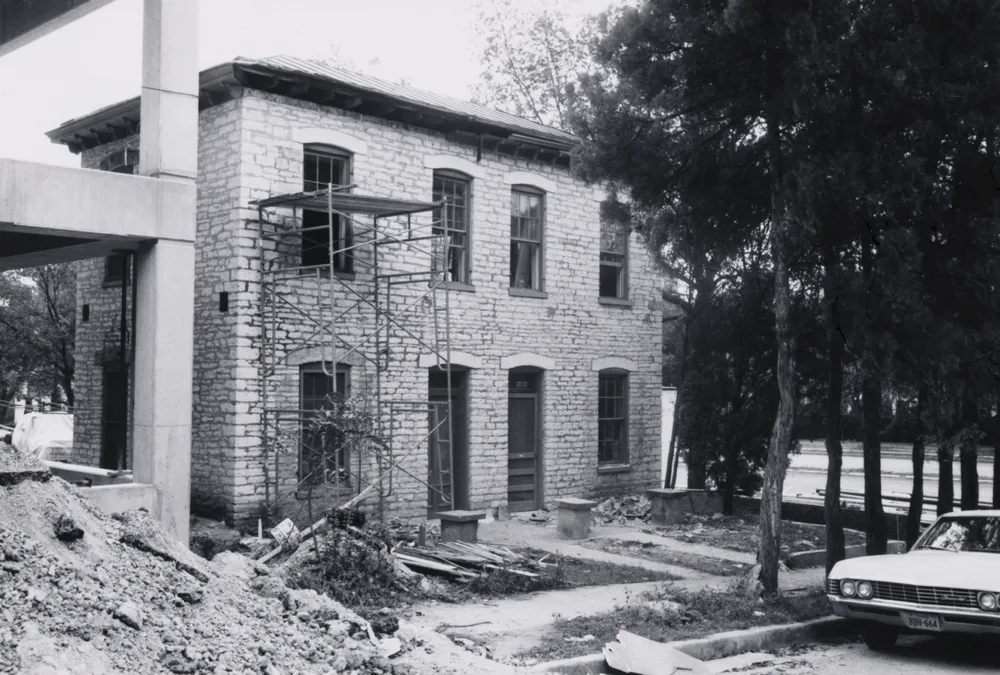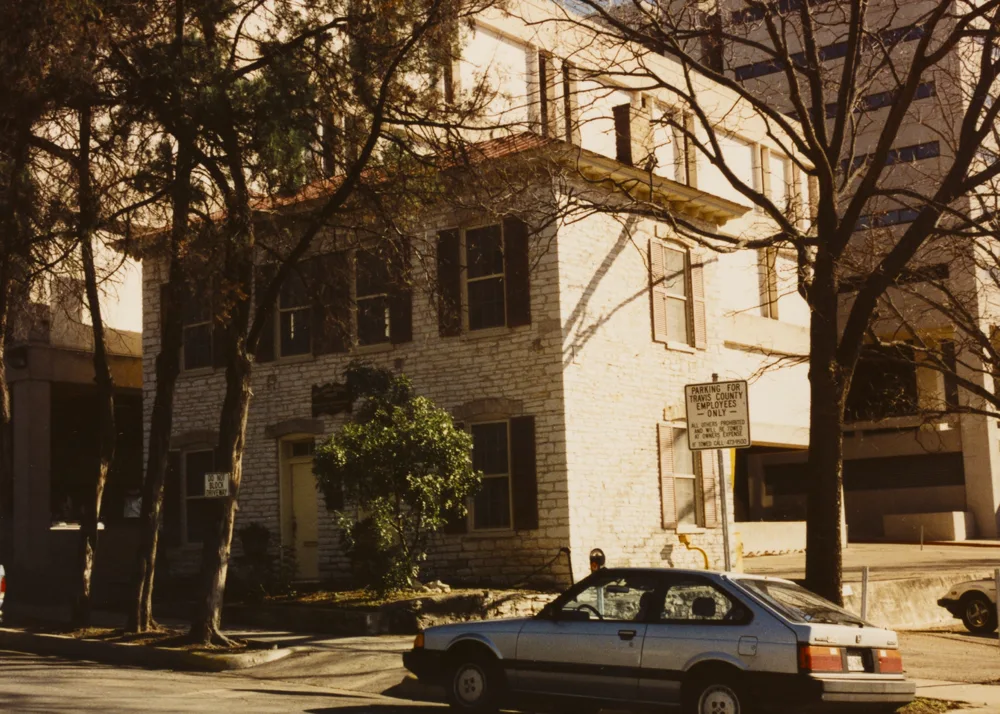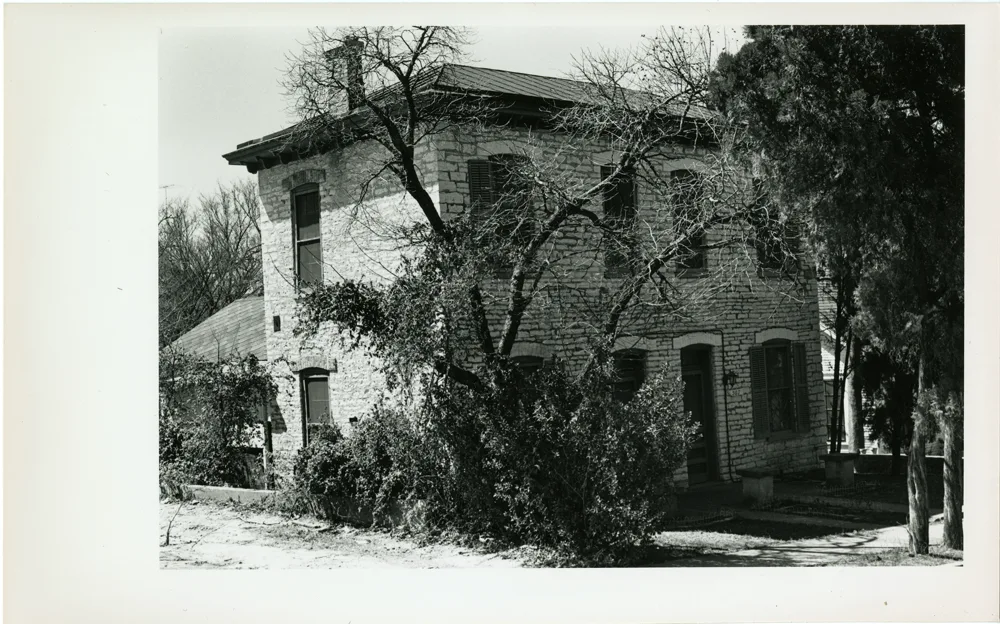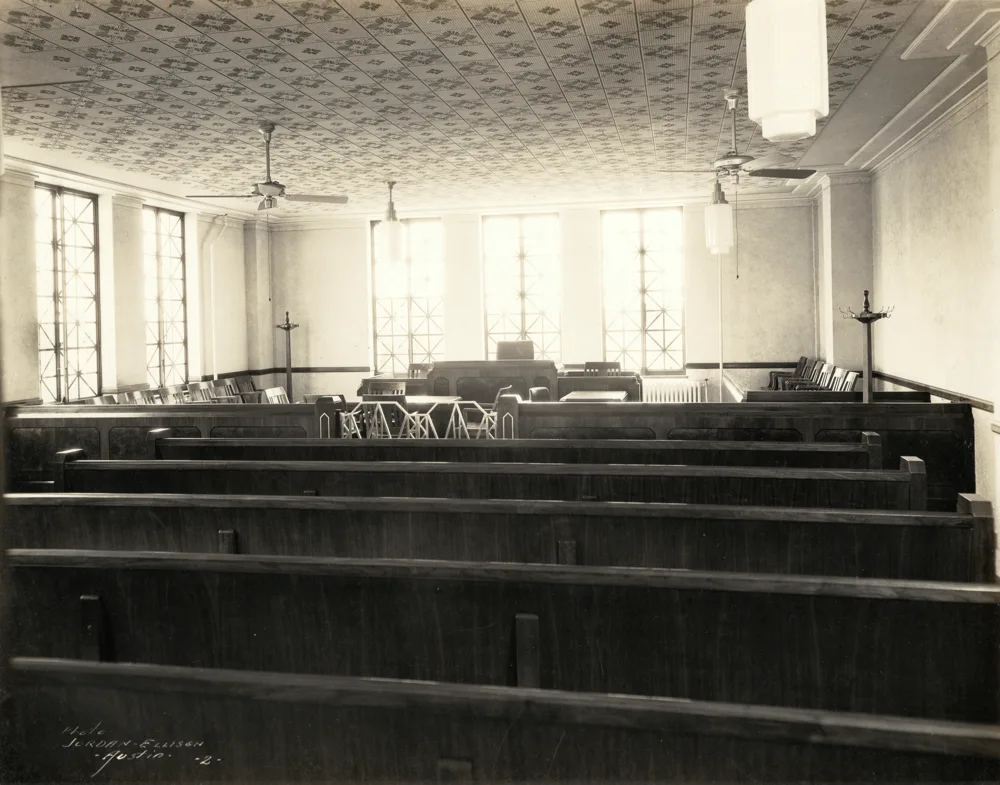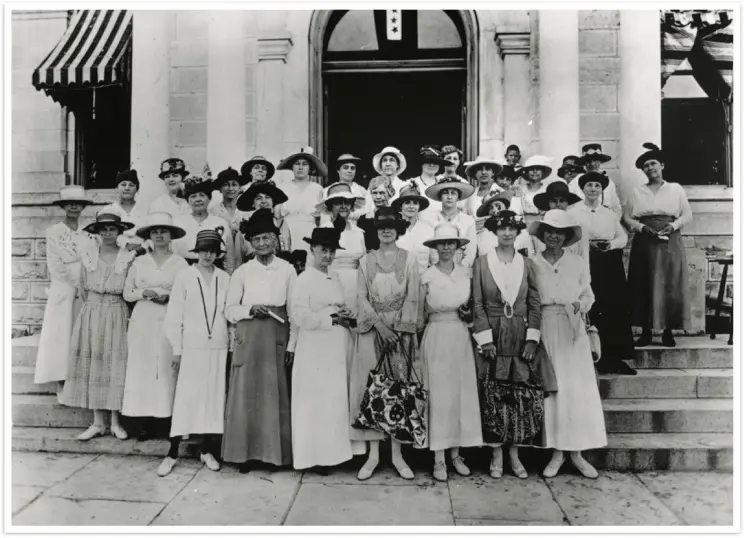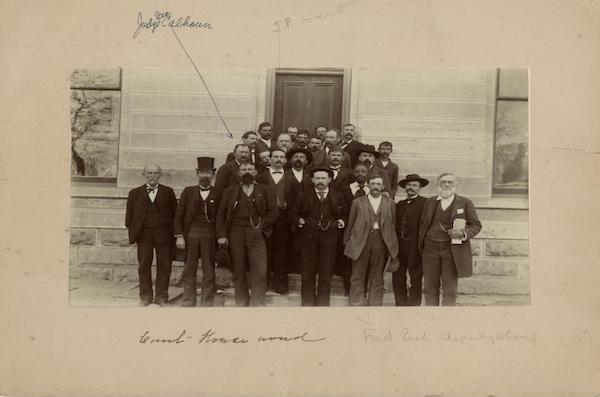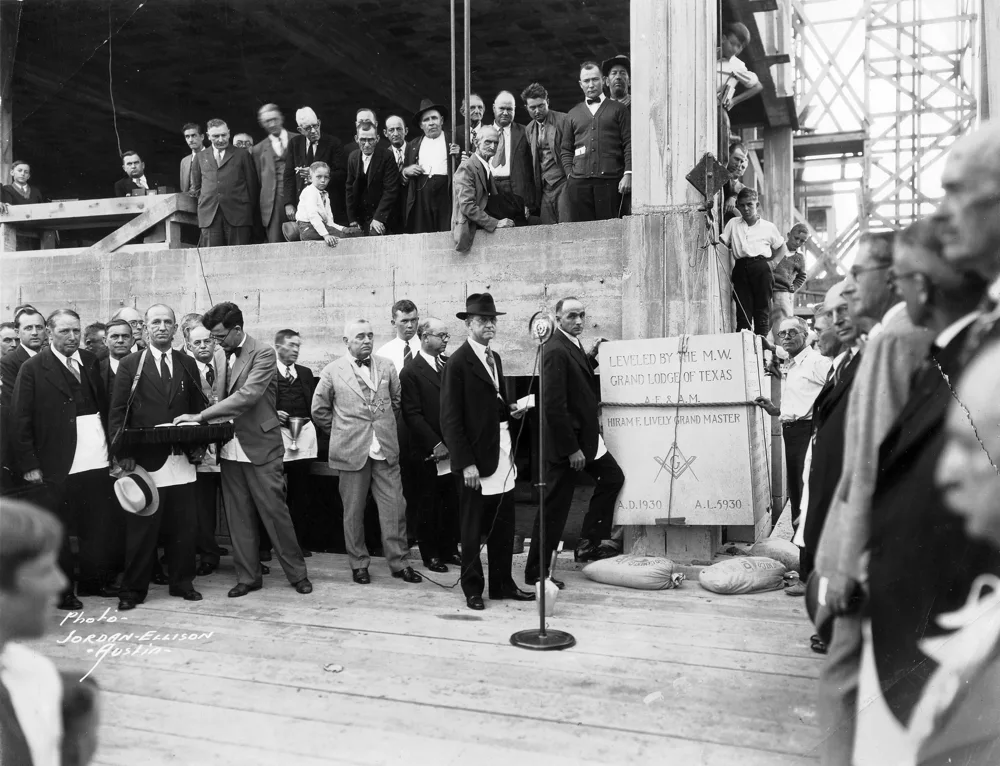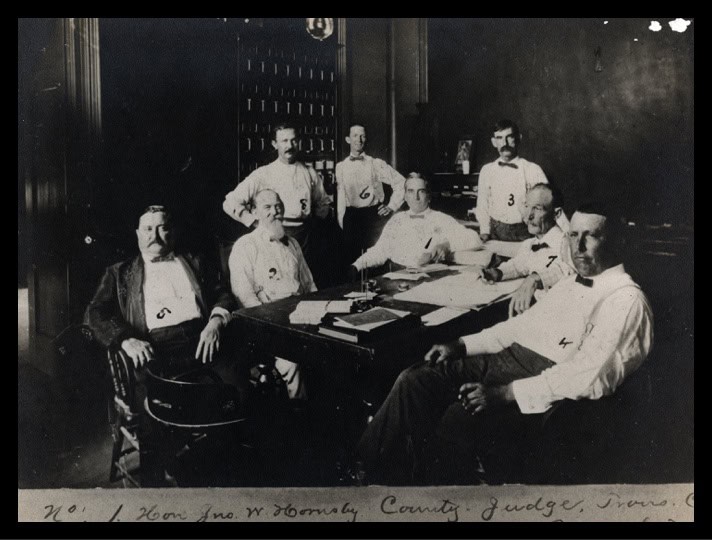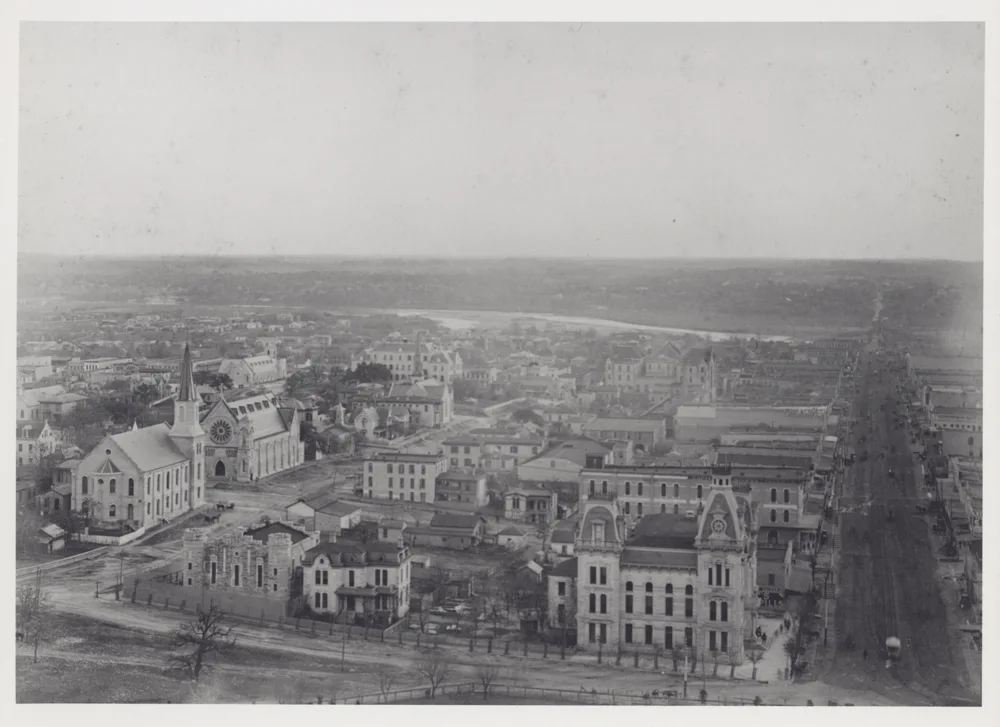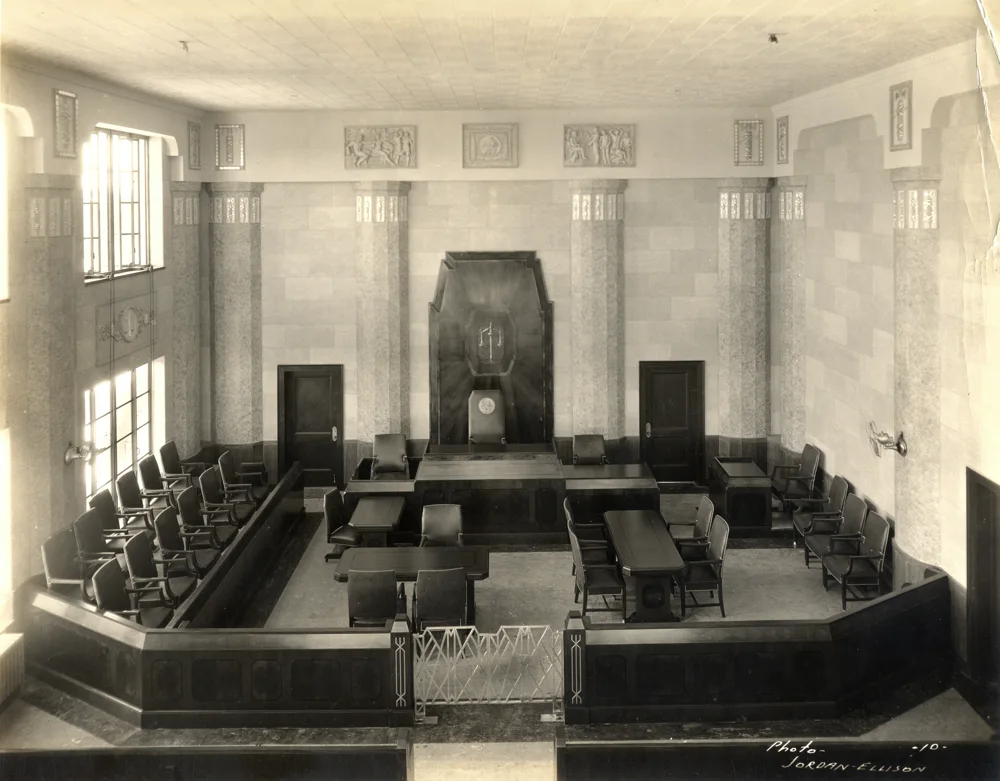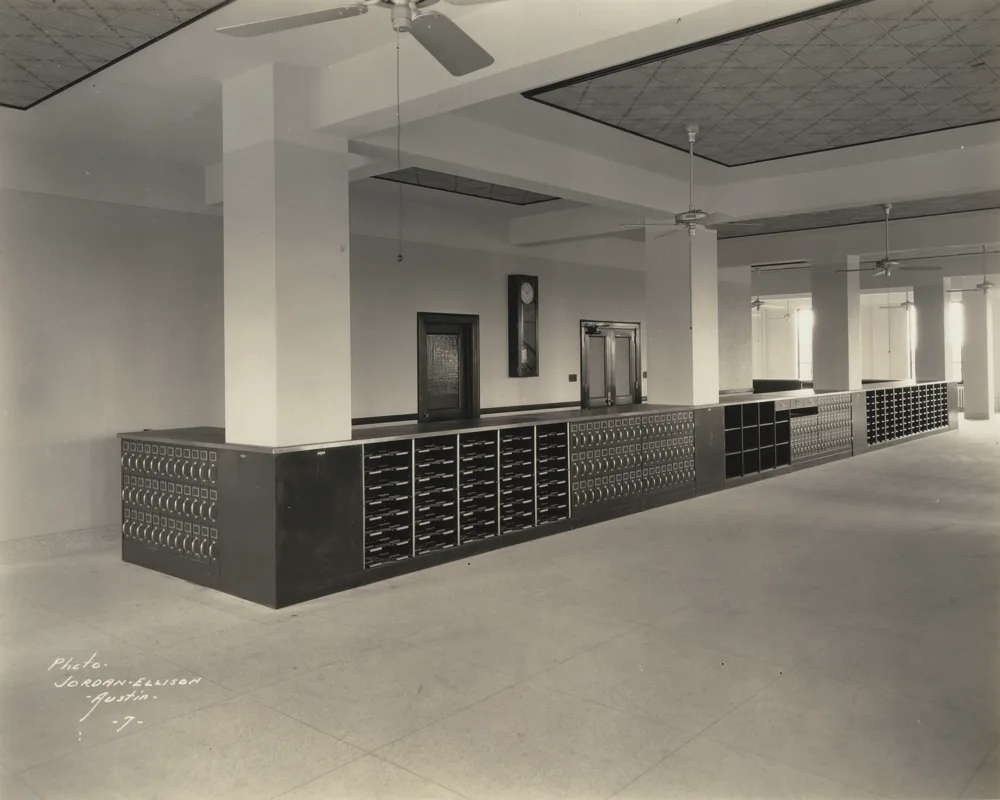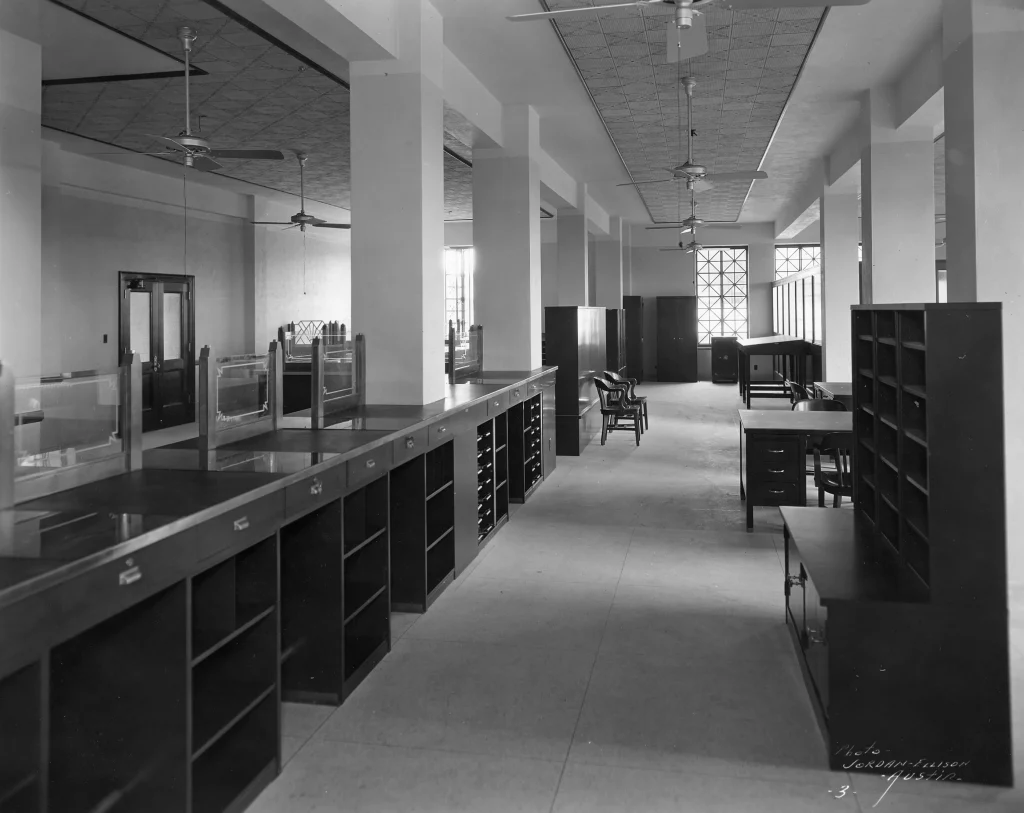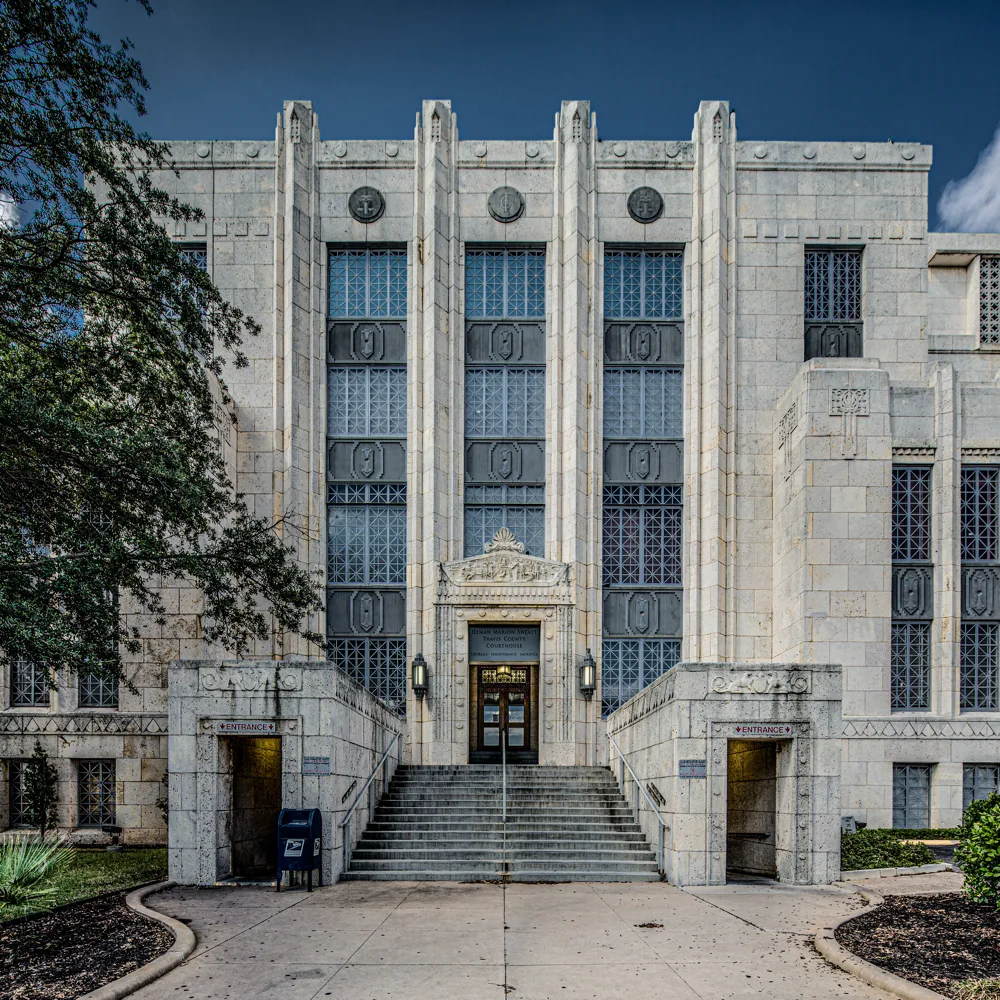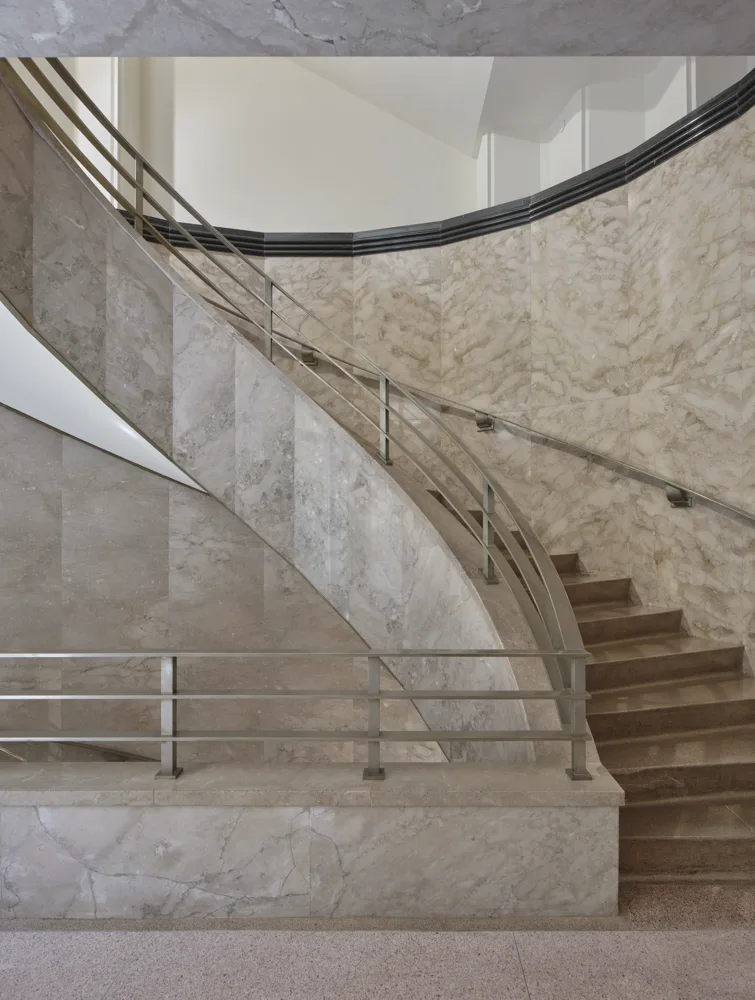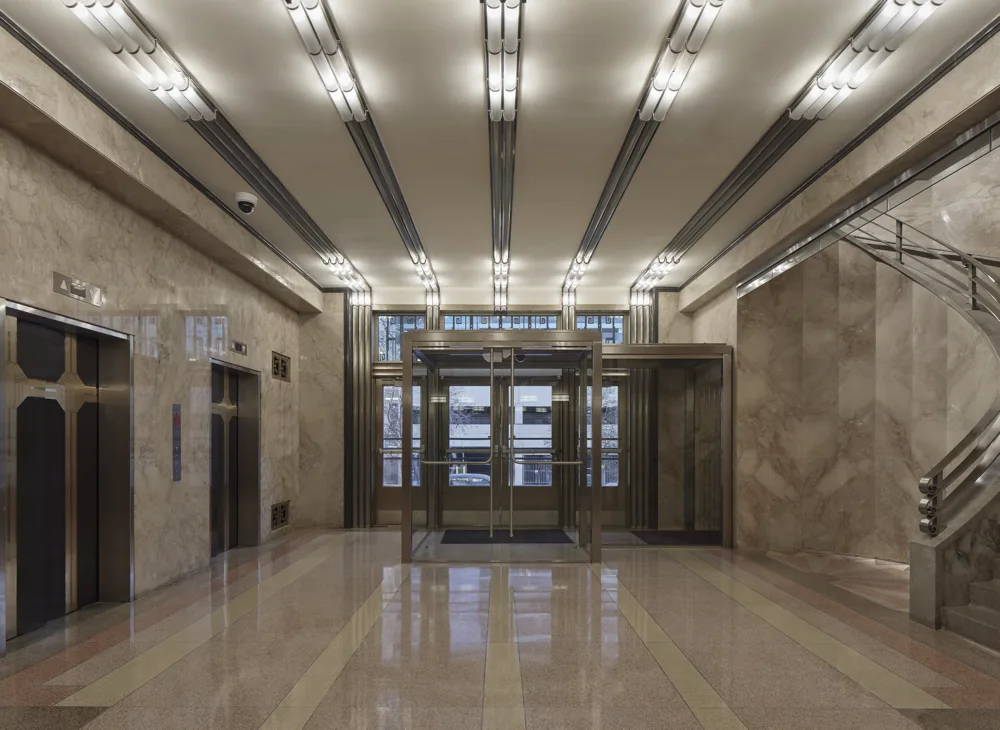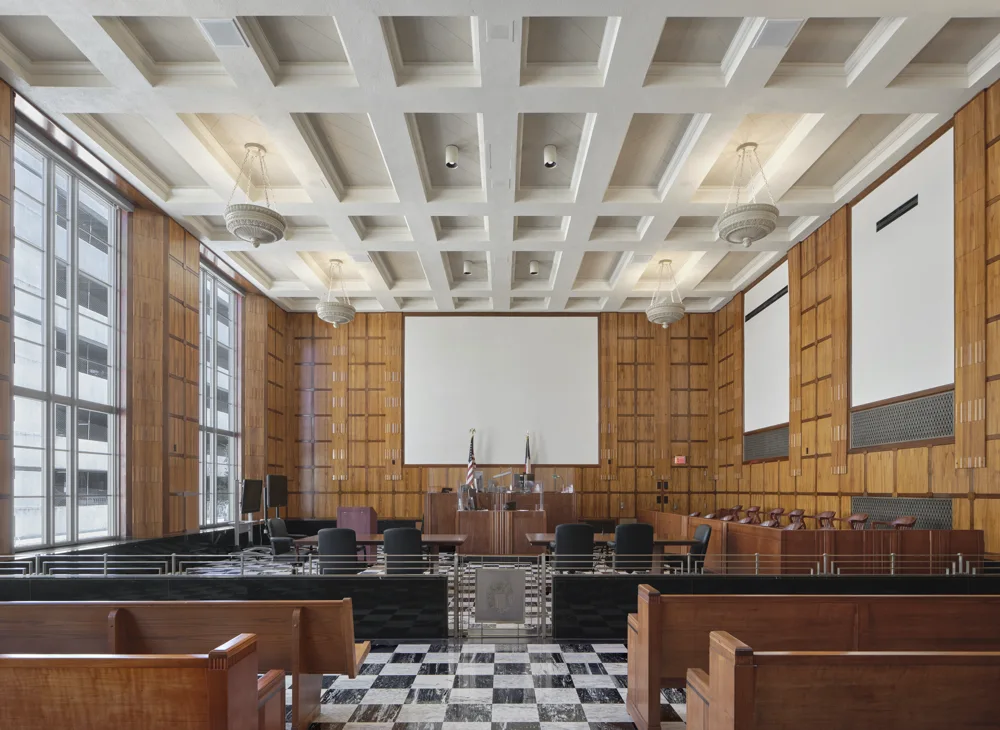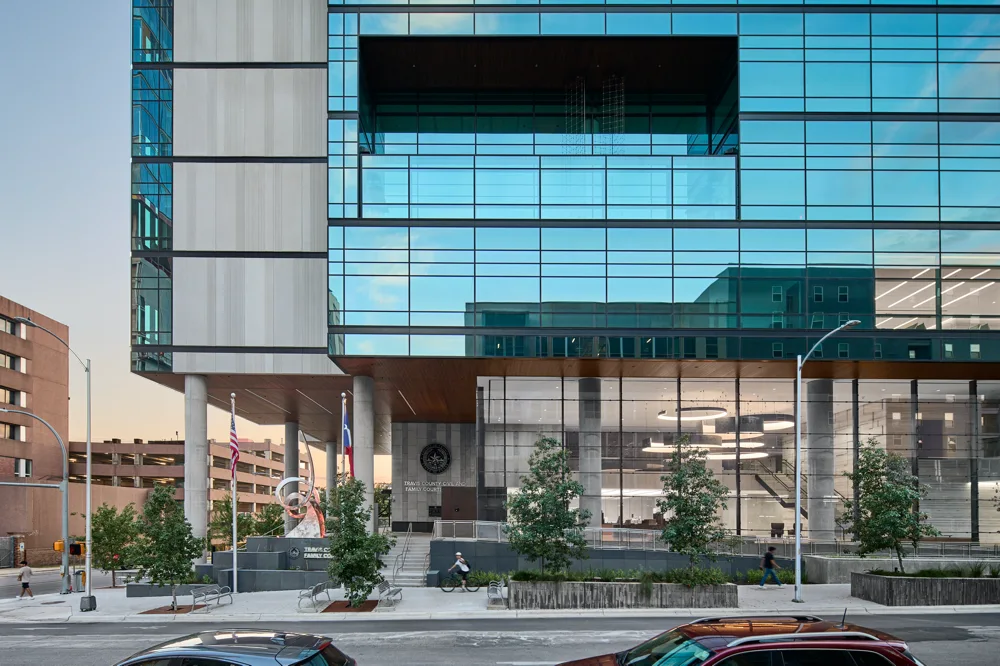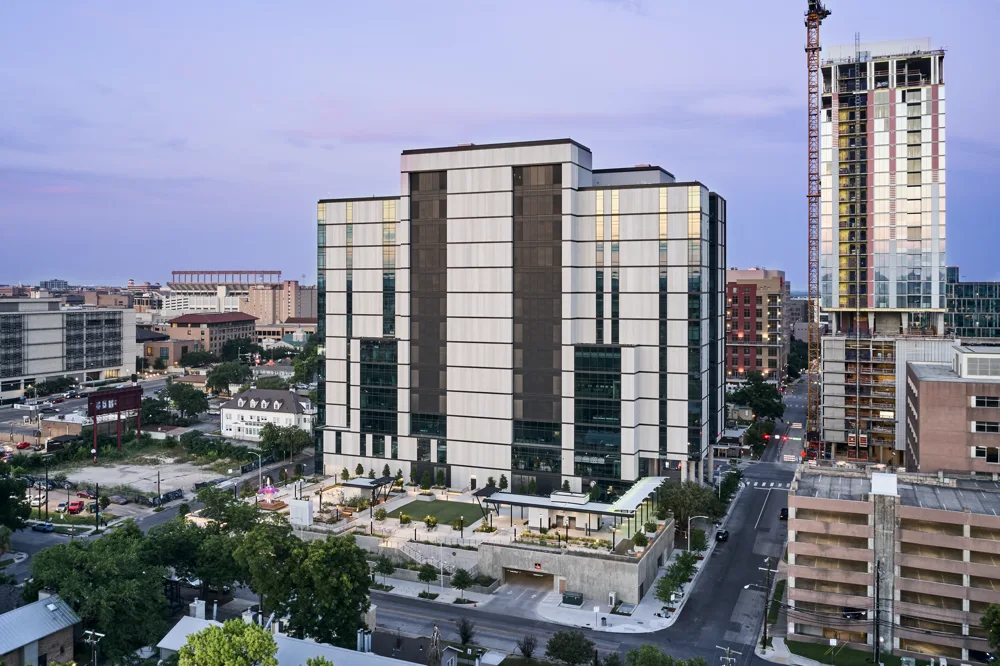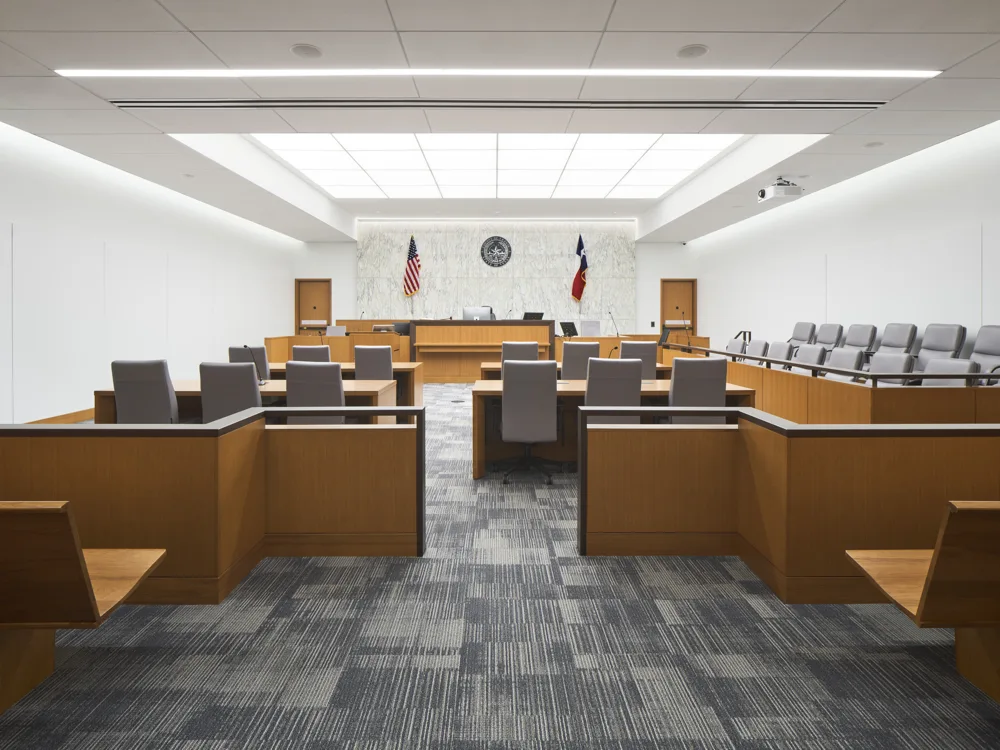History Day 2024
Travis County Courthouses: A Retrospective
Texas has more historic courthouses than any other state. Historically, county courthouses have served as the heart of the community and a hub of social activity. They are a symbol of civic pride, power, and the seat of local government. The courts they house play an essential role in maintaining the rule of law, resolving disputes, and ensuring equal justice.
At the time of Travis County’s establishment in 1840, the population was a mere 856 residents. In 2020, the population of Travis County was 1,290,188 people. This steady and rapid population growth has required the government to adjust accordingly, adding courts to accommodate the increased civil, criminal and family court needs of residents. As the number of courts has increased, so has the need for additional staffing and space, leading to the purchase and construction of additional court facilities.
From land disputes in the earliest days of Travis County, to a landmark civil rights case, to the decisions made by judges and the Commissioners Court, the courthouses of Travis County have served as the backdrop to rulings and resolutions that have shaped the lives of countless citizens.
Exhibit Chapters:
I. A History of the Official Travis County Courthouses
III. 1936 Federal & 2020 Probate Courthouse
IV. Blackwell Thurman Criminal Justice Center
V. 2022 Civil and Family Courts Facility
VIII. Judge Thomas D. Blackwell and Judge Mace B. Thurman, Jr.
IX. Brizedine House
A History of the Official Travis County Courthouses
Since Travis County’s founding in 1840, three buildings, dating from 1855, 1876, and 1931, have served as the official Travis County courthouses.
Before 1855, court was held at various places throughout Austin, wherever space could be found. Recognizing the need for an official courthouse building, the Travis County Commissioners Court decreed that the taxes for 1854-1855 be set aside in a special fund for the building of a courthouse and jail.
1855 Courthouse
In February of 1855, Thomas H. Jones contracted with Travis County to construct a courthouse and jail on the “Court House Square.” This land, located between Cypress and Cedar Streets (now 3rd and 4th Streets), and bounded on the east by Guadalupe Street, had been set aside for such a purpose on the original survey of Austin made in 1839. The resulting stone building was a simple two-story structure, with a belfry on top and a jail in back, and it was completed in the fall of 1855.
It didn’t take long for the County to outgrow these modest accommodations. By the 1860s, the jail was proving to be inadequate, and attorneys, litigants and others complained that the Courthouse location was too far from the center of Austin’s business and commerce district.
1876 Courthouse
Finally, plans for a new courthouse and jail in a more convenient location were approved, and in 1876, the second Travis County Courthouse was constructed at 11th Street and Congress Avenue. The 1855 Courthouse was vacated by the county, and the land was leased out for many years. In 1906, the structure reportedly was deemed unsafe and demolished.
While the old Courthouse had been small and simple, the new Courthouse was monumental, elegant, and ornate. With details such as ironwork cresting, decorative dormers, and Mansard roofs, this three-story limestone building stood directly across from the Texas State Capitol.
Despite the Courthouse’s impressive exterior, however, by 1915 there were reports that it was infested with rats, bats, pigeons, and other vermin. Courtrooms were described as wholly inadequate, and it was said that the jail was a much nicer place to visit.
The cupolas and towers were eventually removed in 1927 in the hopes of ridding the site of unwanted pests, but in 1931, Travis County decided to abandon the Courthouse. The structure, which was then remodeled and put into use as offices for State agencies, was renamed the “Walton Building,” and in 1964, it too was demolished.
1931 Courthouse
The third Travis County Courthouse was built on land purchased at 10th and Guadalupe Streets, adjacent to the north end of Wooldridge Park. The cornerstone was laid in 1930 and construction was completed the following year, with the grand opening held in the summer of 1931. The Courthouse was built to house all county offices and staff, including precinct and minor offices, elected official suites, courtrooms, witness and jury rooms, and jury dormitories. The county jail was located on the sixth and seventh floors and included the jailer’s offices and quarters and jail cells for both men and women.
Designed in the Moderne style by Page Bros. Architects and constructed by H.E. Wattinger Contractors, the 1931 Courthouse was in sharp contrast with its predecessor. As originally designed and built, the Courthouse was a refined, symmetrical building, with clean lines, details of geometric shapes and patterns, and bronze entrance doors on all four sides. Many of the original details remain today, such as pilasters that sweep from the original entrance up to the top of the building, and interior elements including a central marble staircase with wrought-iron railings, a decorative terrazzo floor, and plaster relief panels with symbols of justice.
By the 1950s, the population of Travis County had tripled, and county government offices once again found themselves in need of additional space. Significant additions to the Courthouse were constructed in 1958 and again in 1962; two three-story additions were added to the north and south sides and extensive renovations were completed to the interior. Eventually, the grand main entrance at the east end of the second floor was closed due to security needs, as was the entrance facing Wooldridge Park. The jail on the top two floors of the Courthouse was closed in 1990, following the construction of a new jail in a separate building.
On October 21, 2005, Travis County renamed the Travis County Courthouse the “Heman Marion Sweatt Travis County Courthouse.” Sweatt was an African-American civil rights activist who challenged the “separate but equal” doctrine in Travis County District Court in 1946.
As population growth in Travis County continued to strain the Courthouse’s capacity, the county made plans to replace the 1931 courthouse with a new, larger facility. Officials selected a county-owned downtown lot near the site of the first county courthouse, and in 2015, the Travis County Commissioners Court voted to propose a $287 million municipal bond issuance to fund a new courthouse complex. In the November 2015 general election, however, the bond measure was rejected by Travis County voters, and the county instead enacted a preservation master plan in 2016 to provide for necessary repairs to the existing courthouse.
After the defeat of the courthouse bond, the county began pursuing other avenues for expanding space for its court facilities, eventually leading to the transformation of the old US Federal Courthouse building into the Probate Courthouse, and the opening of the Civil and Family Court Facility. As many courts and offices have moved to the new facilities, plans remain for a historic restoration of the 1931 Travis County Courthouse.
Heman Marion Sweatt
“[Heman Sweatt] was an ordinary person, but he had an extraordinary dream to live in a world in which Afro-Americans and whites alike were afforded equal opportunity to sharpen their skills and to hone their skills, to sharpen their minds.” -Thurgood Marshall
On October 21, 2005, Travis County renamed the Travis County Courthouse the “Heman Marion Sweatt Travis County Courthouse.”
Heman Marion Sweatt was born in Houston in 1912. After earning a degree from Wiley College in Marshall, Texas, in 1934, Sweatt returned to Houston to work as a mailman. During the early 1940s, he participated in voter-registration drives in the African American community and attended National Association for the Advancement of Colored People (NAACP) meetings. As the local secretary of the National Alliance of Postal Employees, Sweatt helped challenge employment discrimination in the post office, where Black employees were excluded from supervisory positions.
In 1946, Sweatt applied to the University of Texas School of Law and was denied admission in accordance with state law, which required segregation by race. The Court of Civil Appeals would later write that “he possessed every essential qualification for admission, except that of race, upon which ground alone his application was denied.”
Mr. Sweatt filed a lawsuit in Travis County against UT President T.S. Painter on May 16, 1946. Judge Roy C. Archer of the 126th District Court, recognizing that the State had no “separate but equal” facility for a law school, gave the State of Texas six months to “establish a law school for Negroes substantially equivalent” to the University of Texas School of Law, and officials of the University of Texas complied. Judge Archer concluded that the new school offered the petitioner “privileges, advantages, and opportunities for the study of law substantially equivalent at the University of Texas.”
Mr. Sweatt’s legal team, led by Thurgood Marshall, disagreed and appealed the decision. Ultimately, in 1950, the Supreme Court of the United States overturned the lower court’s ruling. While not yet denouncing “separate but equal” as the constitutional policy of the United States, the Court wisely saw beyond the bricks and books that make a school and concluded that separate professional schools were inherently unequal. Sweatt laid the groundwork for the Court’s decision in 1954’s Brown v. Board of Education of Topeka. In Brown, the Court finally concluded that, although the physical facilities may be equal, segregation of children in public schools solely based on race deprives the children of equal education opportunities. Sweatt gave the court the logic that enabled it to strike down segregation as the law of the land by providing an interim step in the process of legal analysis.
1936 Federal & 2020 Probate Courthouse
Travis County’s Probate Courthouse is the former federal courthouse in downtown Austin. Constructed in 1935-1936, the Federal Courthouse housed the Austin division of the United States District Court for the Western District of Texas and other judicial offices until 2012, when a new federal courthouse building was completed.
The four-story building exemplifies Depression-era Moderne architecture with its symmetrical rectangular form, recessed vertical window bays, and smooth stonework exterior decorated with neoclassical flourishes, stylized eagles and geometric detailing. The building was designed by local architect Charles Henry Page, who also designed the Heman Marion Sweatt Travis County Courthouse. The structure was added to the National Register of Historic Places in 2001.
The building’s interior exhibits Art Moderne and Art Deco finishes and detailing. The lobbies and corridors have marble and plaster walls, geometrically patterned terrazzo floors, and plaster ceilings with white bronze molding. The ceremonial courtroom is a double-height chamber with wall paneling of light book-matched wood set in darker wood squares and a coffered plaster ceiling. Light fixtures range from white-bronze-and-glass chandeliers to wall sconces with Art Deco detailing.
In 2016, Travis County began talks about using the federal building for additional county court space, in part because of the recent failure of a bond measure to raise funds to replace the aging Travis County Courthouse.
At a press conference on December 29, 2016, officials from Travis County and the federal judiciary as well as local U.S. Representative Lloyd Doggett announced that ownership of the courthouse had been transferred to Travis County. The county budgeted $28 million to bring the structure up to current building codes and adapt it for use as the new site of the county probate courts.
Exterior work included repairing limestone masonry, delicate cleaning of cast iron spandrels, and fabricating aluminum replacement windows to restore the graceful profile of the originals. On the interior, intricate woodwork and historic light fixtures were meticulously restored.
After a 17-month renovation, staff from the probate court and the County Clerk’s office moved into the building in October 2020, and the facility was rededicated on November 18, 2020.
Blackwell Thurman Criminal Justice Center
Located at 501 W. 11th street, on the west side of the Heman Marion Sweatt Travis County Courthouse, the Blackwell Thurman Criminal Justice Center was opened in December of 2000.
Designed in the Modern style, the 10-story concrete and glass building was constructed to house the Travis County criminal courts and to connect the Travis County Jail with the Courthouse Annex. Bonds for the structure were approved in 1993, although construction was delayed in the design phase to accommodate for the preservation of the Brizendine House, a historic home that still stands today. Further delays occurred during construction, leading the project to be finished behind schedule and over budget. The design and operational problems that occurred resulted in litigation between Travis County and the architects and contractors.
The Criminal Justice Center was named for long-serving Judges Thomas D. Blackwell and Mace B. Thurman, Jr. Judge Blackwell served as County Attorney (1955-1962), District Attorney (1962-1968), and 167th District Court Judge (1968-1984). Judge Thurman served as Justice of the Peace Precinct 3 Pl. 2 (1941-1947), County Court at Law #1 Judge (1947-1957), and 147th District Court Judge (1957-1990).
2022 Civil and Family Courts Facility
The Travis County Civil and Family Courts Facility was built to serve the growing Austin and Travis County community for years to come.
In 2009, a Central Campus Needs Assessment was initiated by Travis County to understand what space would be required to house the staff and services needed to adequately serve residents from 2009 to 2035. The effort, completed in 2010, indicated a significant space deficiency then, and that space shortage would only be exacerbated by the projected County growth in upcoming years.
At the completion of the Needs Assessment, it was clear that Travis County would need to take deliberate steps to both increase and improve its Central Campus facilities over the next several years to accommodate County services. The Central Campus Master Plan established a strategic plan for the facilities development required to accommodate the civil and criminal justice system and several general government functions through and beyond the 2035 planning horizon, including a new Civil & Family Courts Complex.
Travis County issued a Request for Proposals for a New Courts Facility in 2018. That year, Travis County entered exclusive negotiations with one respondent for a new courts facility to be located at 1700 Guadalupe Street. Construction began in 2019, and the 12-floor building was opened in 2022. In addition to 25 courtrooms, the building features dedicated spaces for children to testify, a short-term child drop-off center for court users, separate and safe waiting areas for victims, a state-of-the-art law library and self-help center, space for attorney-client conferences, and a large multi-function room that can be used for public events.
Commissioners Courtrooms
The Commissioners Court is the general governing body of the county, and functions as both the legislative and executive branch of county government. The major duties of the Commissioners involve overseeing the budgetary and policy-making functions of the county, managing county operations, and providing oversight of the county’s infrastructure.
The Commissioners Court has held its meetings in various locations throughout the years. In the 1931 Courthouse, the Commissioners met on the 3rd floor (designated as the 2nd floor on the blueprints).
When the Annex, later called the Gault building, was constructed in the early 1970s, the Commissioners Court moved into that building.
In the early 1990s, voting sessions were once again moved, from the Gault Building to the Stokes Building, later renamed the Ned Granger Building, at 314 W. 11th Street. Upon the county’s purchase of a new administrative building at 700 Lavaca Street in 2010, a new Commissioners Courtroom was constructed, and it opened in the fall of 2012.
The County Seal & Flag
The first official Travis County seal was adopted in January of 1964. Featuring a geometric and art deco design, the county seal was created from a bronze plaque that was installed on the Courthouse when it was built in 1930-1931.
In 1964, Jessie McIlroy Smith of the Travis County Historical Survey created a flag for the county’s 125th anniversary. It consisted of the county seal in gold on a field of blue, and nestled in each corner of the flag was a gold inward-pointing fleur-de-lys, representing the four Commissioner precincts.
The current Travis County seal was designed by County Treasurer Johnny Crow and adopted in 1975. A document called “The Legend of the Official Travis County Flag and Seal” details the history of the seal.
An act of the 64th Legislature of the State of Texas in 1975 amending article 2344, enabled the counties of Texas to optionally allow an official seal to be designed depicting imagery indigenous to their respective counties.
Such a seal for Travis County was designed and submitted to Judge Mike Renfro (1971-1986) by Johnny Crow (1959-1986), County Treasurer of Travis County.
The Judge liked the design and brought the same before the Commissioner’s Court for their consideration and possible adoption.
The seal’s overall design is original, but the symmetry and dignity of the famous State seal remains; it uniquely preserves the oak and pecan tree wreath as it encircles the Texas Lone Star (which is as it should be since county government is an arm of the State). Travis County government was created out of the Mina District of the Texas Republic in 1839, thus the date is portrayed so prominently.
Things in the seal that are indigenous to Travis County are fairly obvious in silhouette form, viz: The State Capitol building, the University of Texas tower, the City of Austin skyline and two vapor trailing Bergstrom AFB jets. Other pertinent forms depicted, yet somewhat less indigenous are a hill country white-tailed deer bounding over a native cactus, a farmer plowing on the rolling east plains, a sailboat sailing on highland lakes…and lastly the perennial justice scales as they symbolize the Travis County and District Court systems.
In summary, the seal is intended to categorically symbolize through imagery the governmental, educational, industrial, military, farming, ranching and recreational factors that predominantly represent the life and economy of the citizenry of Travis County.
The seal was officially adopted and is recorded in the court minutes of June 16, 1975, volume 16 page 371. The following were the presiding officials of the adoption order:
Judge Mike Renfro
Commissioner David Samuelson, Pct. 1
Commissioner Bob Honts, Pct. 2
Commissioners Johnny Vidouris, Pct. 3
Commissioner Richard Moya, Pct. 4
One of the most noticeable aspects of the Travis County seals is the 1839 date. Because Travis County was formally established by an act of the Republic of Texas Congress on January 25, 1840, the 1839 date is a curious detail.
It may be that the date came from the very first entry in the first volume of Commissioners Court minutes, which is dated February 15, 1839. This entry records a proclamation by Chief Justice James W. Smith that divided the county into four militia beats. Closer examination, however, shows that the 1839 date was likely written in error.
The next entries in the Commissioners Court minutes, which assign Justices of the Peace to patrol the militia beats, date from March 1840. More importantly, James W. Smith was not elected by the Republic of Texas Senate as Chief Justice of Travis County until January 30, 1840, five days after Travis County was established. In fact, James W. Smith did not move to Austin until the fall of 1839. These details indicate that the date should have been February 1840 rather than 1839.
That is not to say, however, that Travis County did not exist in 1839, at least in theory and in name. An election return from October 1839 records the election of a first lieutenant to patrol a militia beat in Travis County, indicating the name “Travis County” was already in use by some of the area’s early residents. According to the journals of the Republic of Texas House of Representatives, the name for Travis County was officially proposed and carried on December 16, 1839 (names that did not carry included Campbell, Lamar, and Wharton). So, although Travis County was not formally established until 1840, discussions about the formation of the county and its name were well underway in 1839.
Judge Thomas D. Blackwell and Judge Mace B. Thurman, Jr.
The Blackwell Thurman Criminal Justice Center was named for Judges Thomas D. Blackwell and Mace B. Thurman, Jr.
Judge Thomas B. Blackwell
Judge Thomas B. Blackwell was a decorated World War II veteran who served as Travis County Attorney, District Attorney, and Judge.
A native of Weslaco, Texas, Thomas Blackwell joined the ROTC during college. After his graduation from Officer Training School, he received a commission as a second lieutenant in the United States Army. He was called to active duty in 1940 and rapidly climbed the ranks. For his service he received numerous medals and citations, including the Purple Heart, the Legion of Merit, the Soldier’s Medal, and the Bronze Star. After the war, Blackwell remained in the Texas National Guard, where he rose to the rank of Brigadier General, over the 71st Airborne Brigade. He continued to parachute from airplanes into his 50s, earning him the nickname of “Jumping Judge.”
Blackwell received a Bachelor’s degree from the University of Texas in 1940 and his law degree from UT in 1947. An employee of Travis County for more than 50 years, Blackwell served as 1st Assistant District Attorney from 1949-1954, County Attorney from 1955-1962, District Attorney from 1962-1968, and District Judge of the 167th District Court from 1968-1984. He was a senior District Judge from 1984-2002. As an elected official and veteran of 10 election campaigns, Blackwell never drew an opponent.
As a prosecutor in the 1950s and 1960s, Blackwell was “hellbent on keeping the community safe.” When it came to young defendants who were first-time offenders, Blackwell regularly suggested probation, something he often granted such offenders as a judge. In the late 1960s and early 1970s, Blackwell was uneasy with the harsh sentences mandated by Texas’ drug laws, which did not allow someone convicted of marijuana possession to be sentenced to probation, so he lobbied the Legislature for change. He wrote books on criminal procedure, and he presided over many well-known cases.
Blackwell was known as one of the sharpest legal minds in Texas, a fair judge, and an active member in his community. Judge Blackwell passed away in 2005.
Judge Mace B. Thurman, Jr.
Judge Mace B. Thurman, Jr. was born in Manor, Texas. He received a Bachelor of Business degree in 1937 and a Doctor of Jurisprudence in 1939 from the University of Texas.
Thurman practiced law in Austin until 1941, when he was elected Justice of the Peace as a write-in candidate, a position he held until 1947. From 1947-1957, he served as the County Court of Law Judge, until his appointment as judge of the newly created 147th District Court of Travis County in 1957. He served as District Judge until 1990, where he presided over mostly felony cases, and had an election opponent only once.
Judge Thurman took care to make decisions that promoted realistic rehabilitations in criminal cases and domestic harmony in family law cases involving children. He was also an early proponent of probation programs for low-level offenders. Thurman’s tutelage helped turn many of young Austin lawyers into judges and top defense lawyers and prosecutors. He also received numerous awards of service from many community organizations.
Judge Thurman retired in 1990 but continued to hear cases as a visiting judge for more than a decade. Along with former Judge Tom Blackwell, Thurman’s name graces the Blackwell-Thurman Criminal Justice Center.
The Austin American-Statesman described Judge Thurman as “what all elected officials aspire to be – an acknowledged expert in his field; well-respected by the people who know and work for him, and a quiet, but commanding presence.” He was known for his commanding presence on the bench, high standards for lawyers practicing in his court, and compassion, even for criminal defendants. He passed away in 2009.
Brizendine House
Have you ever wondered about that small historic houses on the Courthouse grounds? The Brizendine House is a historic home constructed around 1870. The building is located on 11th Street and is surrounded by the annex to the Heman Marion Sweatt Travis County Courthouse and the Blackwell Thurman Criminal Justice Center.
The house was built of limestone by John R. Brizendine, an Austin carpenter, machinist, and miller, and serves as an example of the lifestyle of the late 19th century working middle-class family in Austin. The house was occupied until 1972, and the house was added to the National Register of Historic Places in 1974. Construction of the Blackwell Thurman Criminal Justice Center in the 1990s was completed to accommodate the preservation of the historic building.
